QuickLinks:
3000, 3001, 3002, 3003, 3004, 3005, 3006, 3007, 3008, 3009, 3010, 3011, 3012,
3013, 3014, 3015, 3016, 3017, 3018, 3019, 3020, 3021, 3022, 3023, 3024, 3025,
3026, 3027, 3028, 3029, 3030, 3031, 3032, 3033, 3034, 3035, 3036, 3037, 3038,
3039, 3040, 3041, 3042, 3043, 3044, 3045, 3046, 3047, 3048, 3049
Page last updated May 24, 2020
Nearly complete, save for following entries, updating corresponding PGC pages
WORKING 3009, 3010, 3034: Updating to current standards
NGC 3000 (= "PGC 5067534")
Recorded (Jan 25, 1851) by Bindon Stoney
Also observed (Apr 1, 1878) by John Dreyer
A pair of stars in Ursa Major (RA 09 48 51.4, Dec +44 07 49)
Historical Identification: Per Dreyer, NGC 3000 (= GC 1928, 3rd Lord Rosse, 1860 RA 09 40 10, NPD 45 12.4) is "very faint, small, irregularly round, mottled but not resolved". The position precesses to RA 09 49 02.6, Dec +44 08 46, but there is nothing there. However, all of Stoney's positions for objects in this region are about 2 arcmin east northeast of the actual object, and a correction for that apparently consistent error falls almost exactly on the pair of stars listed above. Also (per Corwin), micrometric measurements by Dreyer (203.1 arcsec from GC 1924 (= NGC 2998) at position angle 23.6°) place the position right on the pair of stars, so the identification is certain. Note: The double star is listed in LEDA as PGC 5067534, but that designation is not recognized by a search of the LEDA database.
Discovery Notes: Although Dreyer credits the report of the discovery to William Parsons, 3rd Earl of Rosse, he notes that many of Rosse's nebular discoveries were actually made by his assistants, George Stoney, Bindon Stoney and R. J. Mitchell.
Physical Information: Northeastern star magnitude 15.9 at RA 09 48 51.6, Dec +44 07 54, southwestern star magnitude 16.1 at RA 09 48 51.2, Dec +44 07 46. Since the pair is located to the northeast of NGC 2998, see the wide-field image of that object for a view of NGC 3000.
NGC 3001 (= PGC 28027)
Discovered (Mar 30, 1835) by John Herschel
A magnitude 11.9 spiral galaxy (type SAB(rs)bc?) in Antlia (RA 09 46 18.7, Dec -30 26 15)
Historical Identification: Per Dreyer, NGC 3001 (= GC 1929 = JH 3190, 1860 RA 09 40 10, NPD 119 48.0) is "faint, small, round, 12th magnitude star attached at 320°". The position precesses to RA 09 46 19.3, Dec -30 26 41, well within the outline of the galaxy listed above, there is nothing else nearby and the star on the northwestern rim of the galaxy makes the identification certain.
Physical Information: Based on a recessional velocity of 2465 km/sec, NGC 3001 is about 115 million light years away, in good agreement with redshift-independent distance estimates of 105 to 180 million light years. Given that and its apparent size of 4.3 by 3.1 arcmin, it is about 145 thousand light years across.

Above, a 12 arcmin wide DSS image centered on NGC 3001
Below, a 5 arcmin wide DSS image of the galaxy
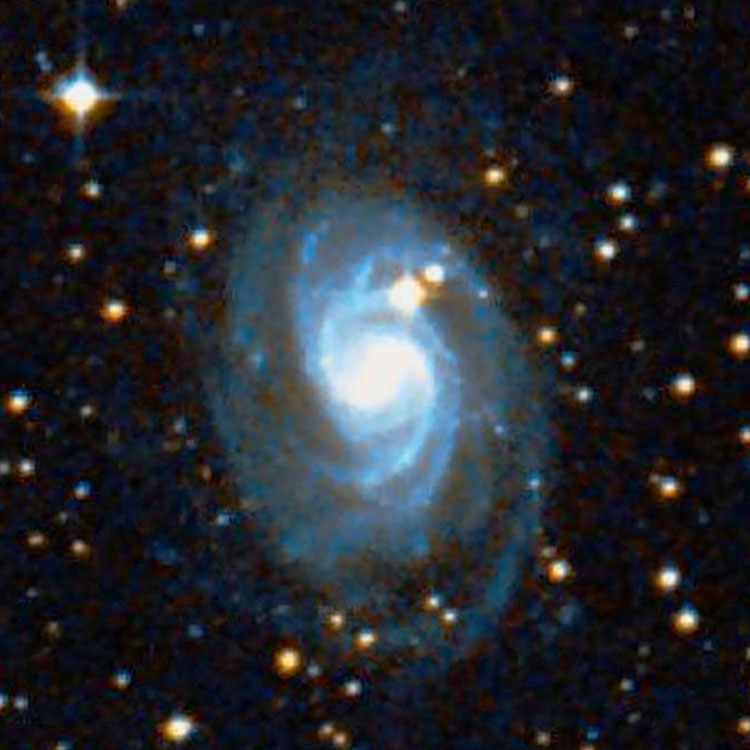
Below, a 3.7 arcmin wide image of the galaxy (Image Credit & © Carnegie-Irvine Galaxy Survey; used by permission)
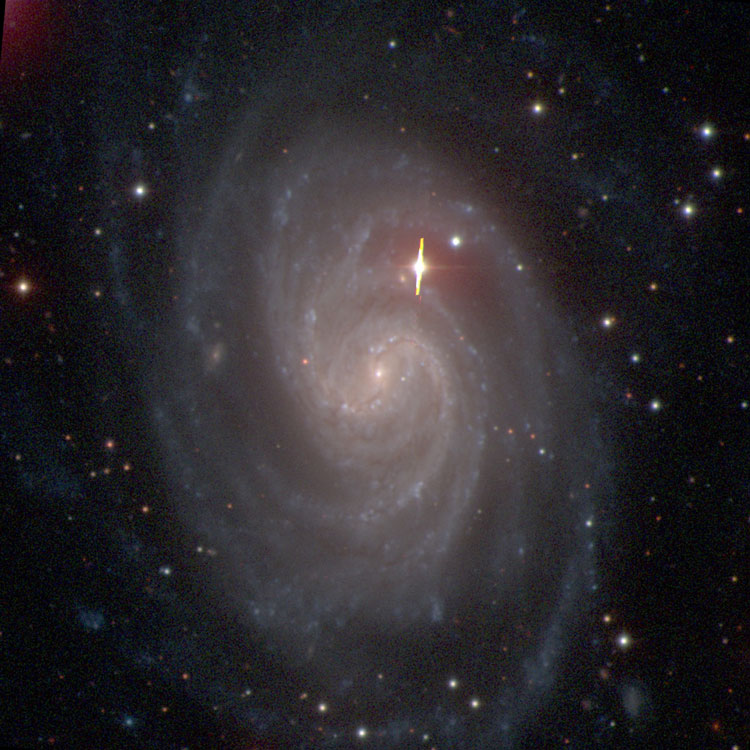
NGC 3002
Recorded (Jan 25, 1851) by Bindon Stoney
Observed and sketched by William Parson, 3rd Earl of Rosse
A magnitude 16.3 star in Ursa Major (RA 09 48 57.4, Dec +44 03 26)
Historical Identification: Per Dreyer, NGC 3002 (= GC 1925, 3rd Lord Rosse, 1860 RA 09 40 12, NPD 45 16.5) is "most extremely faint, very small". The position precesses to RA 09 49 04.3, Dec +44 04 39, an arcmin or two northeast of three faint stars southeast of NGC 2998, but all of Stoney's positions for objects in this region are about 2 arcmin east northeast of the actual object, and a correction for the apparently consistent error falls just west of the star listed above. Corwin notes that the southwestern star is the brightest of the three and therefore most likely what Lord Rosse included in his sketch, so the identification of NGC 3002 with that star is reasonably certain. However (also per Corwin), the MCG miscataloged PGC 28208 (a low-surface brightness galaxy a couple of arcmin southeast of the three stars) as NGC 3002, and as a result many references (including LEDA) still list that galaxy as NGC 3002; it is therefore also discussed, immediately below.
Discovery Notes: Although Dreyer credits the report of the discovery to William Parsons, 3rd Earl of Rosse, he notes that many of Rosse's nebular discoveries were actually made by his assistants, George Stoney, Bindon Stoney and R. J. Mitchell. However, Lord Rosse did make a sketch of the region, so although not the discoverer he did observe the object.
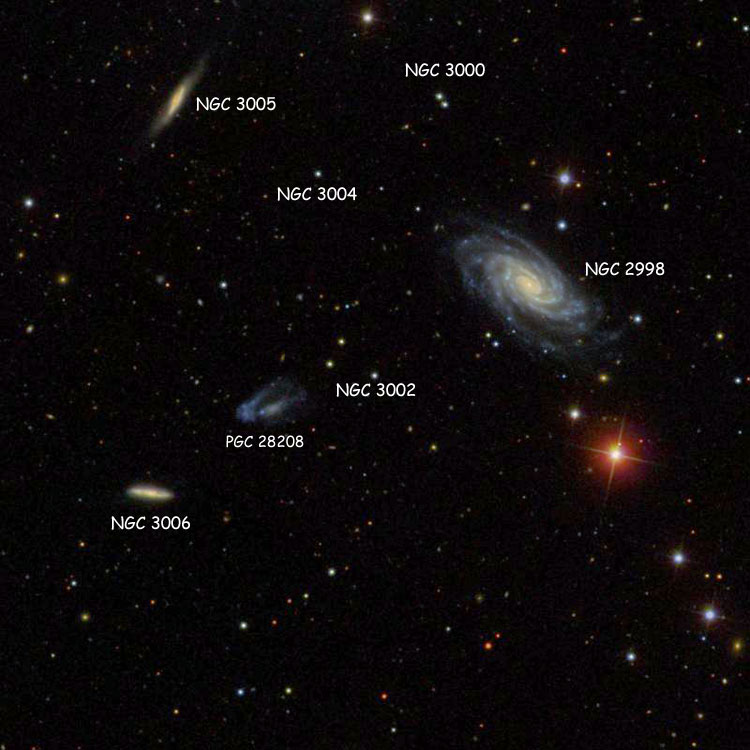
Above, a 12 arcmin wide region centered on NGC 3002
Also shown are NGC 2998, 3000, 3004, 3005 & 3006 and PGC 28208
PGC 28208 (not = NGC 3002)
Not an NGC object but listed here because sometimes misidentified as NGC 3002
A magnitude 17(?) pair of galaxies (type (Irr? + SBa?) pec) in Ursa Major (RA 09 49 06.6, Dec +44 02 57)
Historical Identification: Correctly listed in NED as PGC 28208, but due to an error in the MCG, misidentified as NGC 3002 (which is a star) in a number of references.
Physical Information: Probably a pair of interacting galaxies, most likely irregular or spiral, but given the relatively low quality of the best available images, basically "peculiar" as a result of their interaction. Based on a recessional velocity of 4730 km/sec, PGC 28208 is about 220 million light years away. Given that and its apparent size of 1.1 by 0.45 arcmin, the pair is about 70 thousand light years across.

Above, a 1.4 arcmin wide SDSS image of PGC 28208; see NGC 3002 for a wide-field view of the region
NGC 3003 (= PGC 28186)
Discovered (Dec 7, 1785) by William Herschel
Also observed (Jan 22, 1827) by John Herschel
Also observed (May 12, 1896) by Stephane Javelle
A magnitude 11.9 spiral galaxy (type SBbc?) in Leo Minor (RA 09 48 35.7, Dec +33 25 18)
Historical Identification: Per Dreyer, NGC 3003 (= GC 1931 = JH 639 = WH V 26, 1860 RA 09 40 15, NPD 55 56.2) is "a remarkable object, extremely bright, large, very much extended 90°". The position precesses to RA 09 48 35.0, Dec +33 24 59, on the southern rim of the galaxy listed above, the description is a perfect fit and there is nothing else nearby, so the identification is certain.
Discovery Notes: The second IC notes "= Javelle #1126, J's Δα should be +18.5 seconds instead of -18.5 seconds" ( Δα being the offset in right ascension from his comparison star). This means that Javelle also observed NGC 3003, but thought it a new discovery due to the error in his calculations; and since Dreyer took note of that, Javelle's observation is also noted here.
Physical Information: Based on a recessional velocity of 1480 km/sec, NGC 3003 is about 70 million light years away, in good agreement with redshift-independent distance estimates of 50 to 95 million light years. Given that and its apparent size of 5.5 by 1.2 arcmin, it is about 110 thousand light years across.

Above, a 12 arcmin wide SDSS image centered on NGC 3003
Below, a 5.6 arcmin wide SDSS image of the galaxy

NGC 3004 (= "PGC 5067535")
Recorded (Jan 25, 1851) by Bindon Stoney
Observed and sketched by William Parson, 3rd Earl of Rosse
A magnitude 16.5 star in Ursa Major (RA 09 49 02.5, Dec +44 06 40)
Historical Identification: Per Dreyer, NGC 3004 (= GC 1926, 3rd Lord Rosse, 1860 RA 09 40 20, NPD 45 14.0) is "extremely faint, suspected". The position precesses to RA 09 49 12.4, Dec +44 07 08, not far from the galaxy listed as NGC 3005 (which see for an image), but all of Stoney's positions for objects in this region are about 2 arcmin east northeast of the actual object, and a correction for the apparently consistent error falls almost exactly on the star listed above. In addition (per Corwin) Lord Rosse's sketch of the region clearly shows that NGC 3004 lies about midway between NGC 2998 and 3005, and given the otherwise nearly empty space between the galaxies, the identification of NGC 3004 as that star is certain. Note: The star is listed in LEDA as PGC 5067535, but that designation is not recognized by a search of the LEDA database.
Discovery Notes: Although Dreyer credits the report of the discovery to William Parsons, 3rd Earl of Rosse, he notes that many of Rosse's nebular discoveries were actually made by his assistants, George Stoney, Bindon Stoney and R. J. Mitchell. However, Lord Rosse did make a sketch of the region, so although not the discoverer he did observe the object.
NGC 3005 (= PGC 28232)
Discovered (Jan 25, 1851) by Bindon Stoney
Also observed (Apr 1, 1878) by John Dreyer
Observed and sketched by William Parson, 3rd Earl of Rosse
A magnitude 14.9 spiral galaxy (type Sbc?) in Ursa Major (RA 09 49 15.0, Dec +44 07 50)
Historical Identification: Per Dreyer, NGC 3005 (= GC 1932, 3rd Lord Rosse, 1860 RA 09 40 33, NPD 45 12.5) is "very faint, pretty small, extended north northwest south southeast". The position precesses to RA 09 49 25.3, Dec +44 08 37, about 2 arcmin east northeast of the galaxy listed above, but all of Stoney's positions for objects in this region are about 2 arcmin east northeast of the actual object, so a correction for the apparently consistent error falls almost exactly on that galaxy and the description is a perfect fit, making the identification certain. Dreyer's micrometric measurement (388.5 arcsec from GC 1924 (= NGC 2998) at a position angle of 62.5°) also falls almost exactly on the galaxy, confirming the correctness of that conclusion.
Discovery Notes: Although Dreyer credits the report of the discovery to William Parsons, 3rd Earl of Rosse, he notes that many of Rosse's nebular discoveries were actually made by his assistants, George Stoney, Bindon Stoney and R. J. Mitchell. However, Lord Rosse did make a sketch of the region, so although not the discoverer he did observe the object.
Physical Information: Based on a recessional velocity of 4545 km/sec, NGC 3005 is about 210 million light years away. Given that and its apparent size of 1.4 by 0.2 arcmin, it is about 85 thousand light years across.
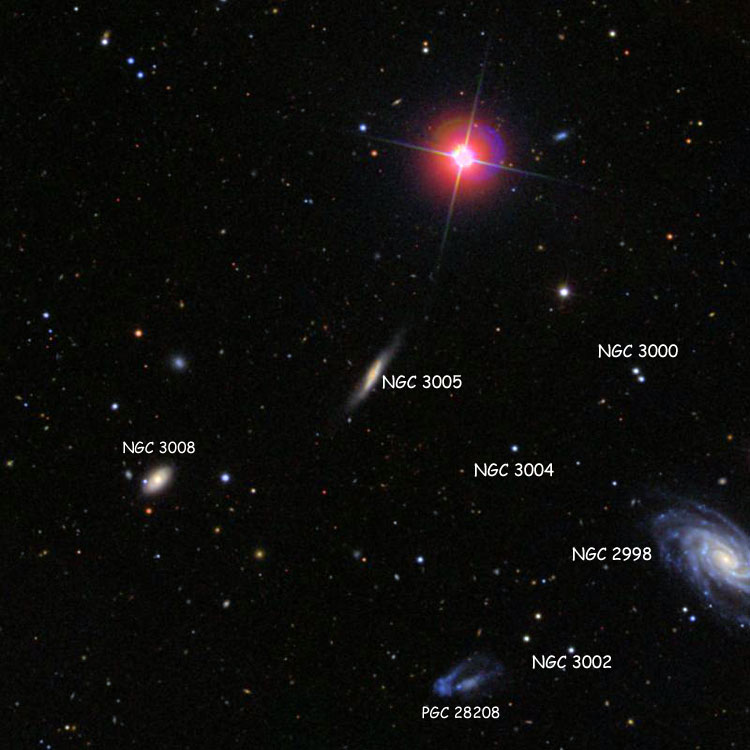
Above, a 12 arcmin wide SDSS image centered on NGC 3005
Also shown are NGC 2998, 3000, 3002, 3004 and 3008, and PGC 28208
Below, a 1.6 arcmin wide SDSS image of the galaxy

NGC 3006 (= PGC 28235)
Discovered (Jan 25, 1851) by Bindon Stoney
Also observed (Apr 1, 1878) by John Dreyer
A magnitude 14.9 spiral galaxy (type Sbc?) in Ursa Major (RA 09 49 17.3, Dec +44 01 33)
Historical Identification: Per Dreyer, NGC 3006 (= GC 1930, 3rd Lord Rosse, 1860 RA 09 40 37, NPD 45 18.7) is "very faint, small, stellar". The position precesses to RA 09 49 28.9, Dec +44 02 24, just over 2 arcmin east northeast of the galaxy listed above, but all of Stoney's positions for objects in this region are about 2 arcmin east northeast of the actual object and a correction for the apparently consistent error falls almost exactly on the galaxy and there is nothing else nearby, so the identification seems certain. [Unlike the three other cases discussed on this page Dreyer's micrometric measurement (417.9 arcsec from GC 1924 (= NGC 2998) at a position angle of 117.2°) does not help with the identification, also falling northeast of the galaxy, but given the situation, the point is moot.]
Discovery Notes: Although Dreyer credits the report of the discovery to William Parsons, 3rd Earl of Rosse, he notes that many of Rosse's nebular discoveries were actually made by his assistants, George Stoney, Bindon Stoney and R. J. Mitchell.
Physical Information: Based on a recessional velocity of 4800 km/sec, NGC 3006 is about 225 million light years away. Given that and its apparent size of 0.75 by 0.25 arcmin, it is about 50 thousand light years across.
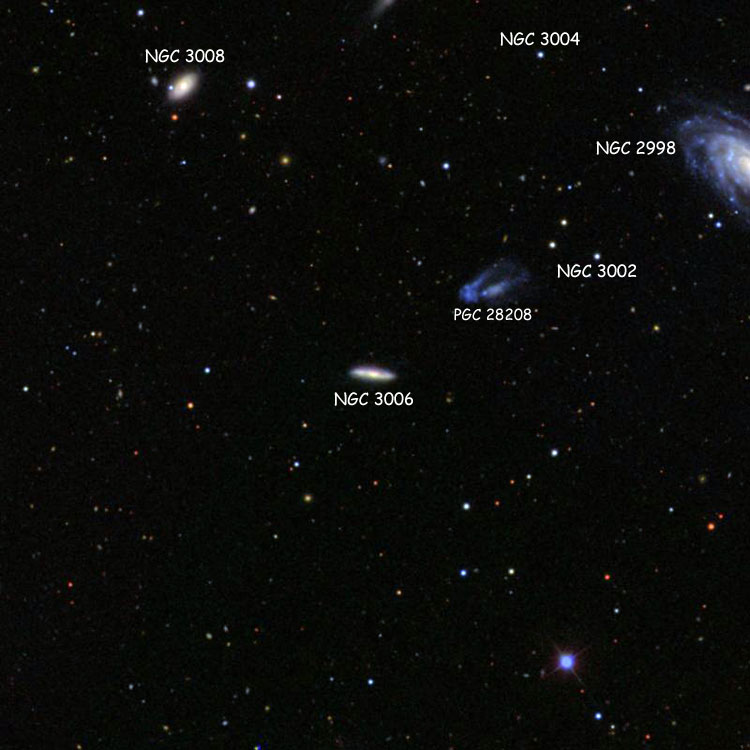
Above, a 12 arcmin wide SDSS image centered on NGC 3006
Also shown are NGC 2998, 3002, 3004 and 3008 and PGC 28208
Below, a 1 arcmin wide SDSS image of the galaxy
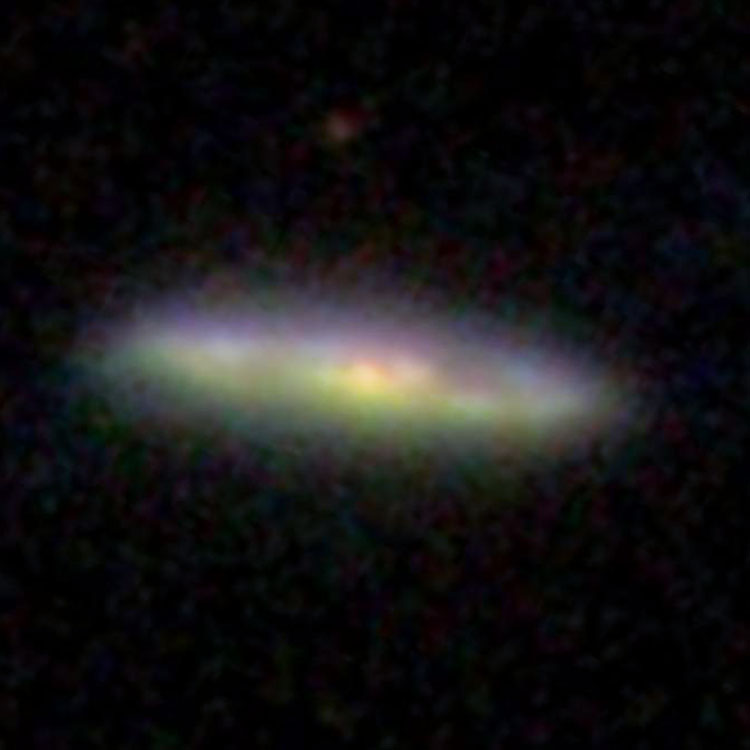
NGC 3007 (= PGC 28150)
Discovered (Mar 16, 1885) by Édouard Stephan
Also observed (Feb 23, 1886) by Francis Leavenworth
A magnitude 13.4 lenticular galaxy (type S0(r)a? pec) in Sextans (RA 09 47 45.6, Dec -06 26 17)
Historical Identification: Per Dreyer, NGC 3007 (Stephan list XIII (#52), Leavenworth list I (#158), 1860 RA 09 40 47, NPD 95 47.4) is "extremely faint, small, irregularly round, a little brighter middle, mottled but not resolved". The position precesses to RA 09 47 46.1, Dec -06 26 12, right on the galaxy listed above and there is nothing else nearby, so the identificaton is certain.
Physical Information: Based on a recessional velocity of 6520 km/sec, NGC 3007 is about 305 million light years away. Given that and its apparent size of 1.3 by 0.65 arcmin, it is about 115 thousand light years across.
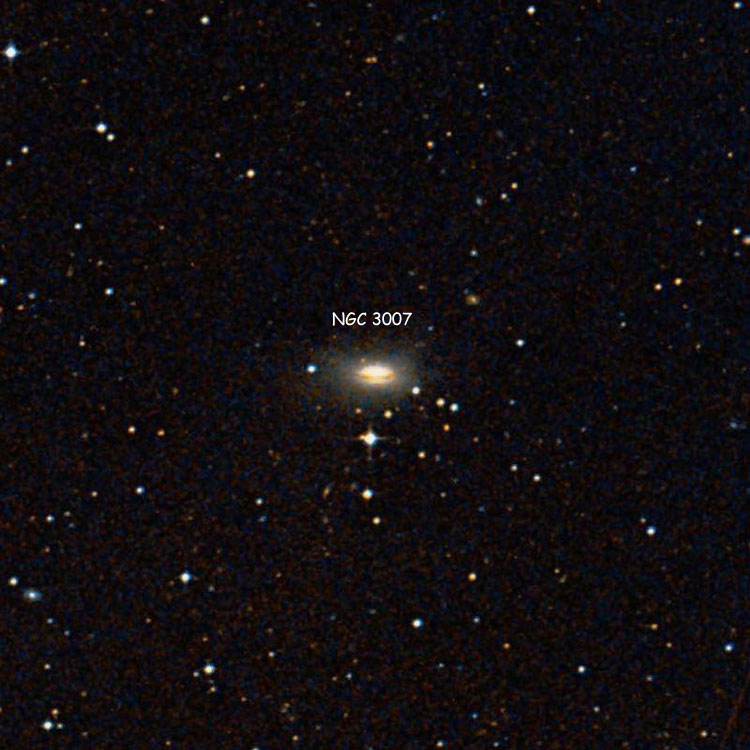
Above, a 12 arcmin wide DSS image centered on NGC 3007
Below, a 1.6 arcmin wide DSS image of the galaxy
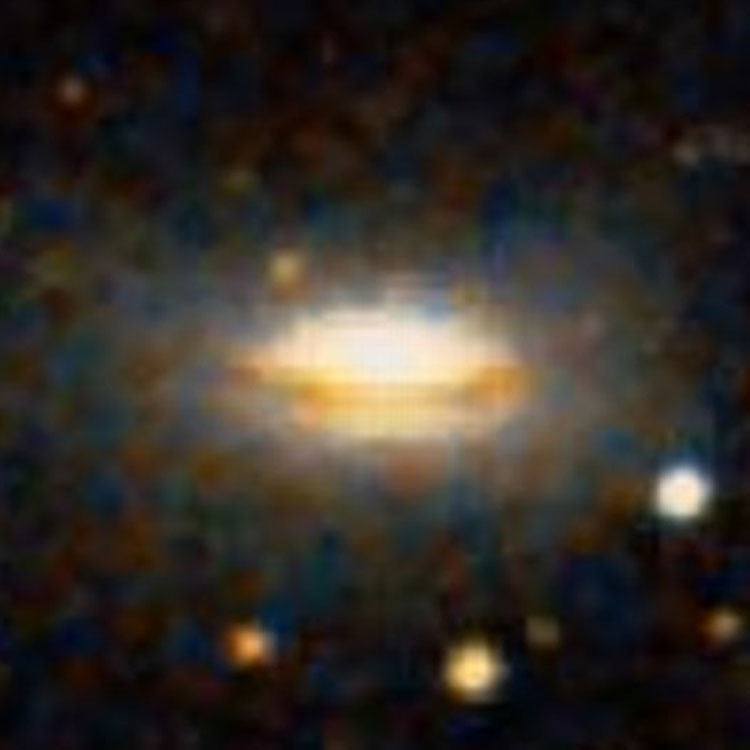
NGC 3008 (= PGC 28252)
Discovered (Jan 25, 1851) by Bindon Stoney
Also observed (Apr 1, 1878) by John Dreyer
A magnitude 14.5 lenticular galaxy (type S0(rs)a?) in Ursa Major (RA 09 49 34.3, Dec +44 06 10)
Historical Identification: Per Dreyer, NGC 3008 (= GC 1934, 3rd Lord Rosse, 1860 RA 09 40 54, NPD 45 15.4) is "pretty faint, small, extended, 13th or 14th magnitude star one arcmin to west". The position precesses to RA 09 49 45.9, Dec +44 05 41, about 2 arcmin east southeast of the galaxy listed above, which means if Stoney's nearly constant error for the objects he observed in the region (about 2 arcmin east northeast of all the others) is applied to the NGC position, the resulting position falls just over an arcmin south of the galaxy. Dreyer's micrometric measurement (552 arcsec from GC 1924 (= NGC 2998) at a position angle of 88°) also falls a little over an arcmin south of the galaxy, confirming that the correction applied to the NGC position is reasonable. In summary, the "corrected" positions are reasonably close to the galaxy, there is nothing else nearby and the description is a perfect fit (most tellingly, including the star an arcmin west of the galaxy), so the identification is certain.
Discovery Notes: Although Dreyer credits the report of the discovery to William Parsons, 3rd Earl of Rosse, he notes that many of Rosse's nebular discoveries were actually made by his assistants, George Stoney, Bindon Stoney and R. J. Mitchell.
Physical Information: Based on a recessional velocity of 4785 km/sec, NGC 3008 is about 225 million light years away. Given that and its apparent size of 0.6 by 0.3 arcmin, it is about 40 thousand light years across.

Above, a 12 arcmin wide SDSS image centered on NGC 3008
Also shown are NGC 3004, 3005 and 3006 and PGC 28208
Below, a 0.8 arcmin wide SDSS image of the galaxy

JUNE 2, 2015 WARNING: The identification of NGC 3009 as PGC 28303 is certainly wrong, and my reluctant identification of it as being reasonable for a few days in late May and early June (as unfortunately still shown at the link for that object) has been reversed, thanks to communications with Dr. Corwin. Prior to those, we separately doubted the accuracy of the identification but felt reluctant to challenge it; but he has now done enough additional research to confirm our suspicions, and there is now no doubt that John Herschel's 640 (which was the basis for NGC 3009) must be PGC 28330, as discussed immediately below, and that Herschel either never saw PGC 28303 or at least had no idea that it was a nebular object. It will take several hours for me to condense the arguments involved into a reasonably brief but hopefully completely clear explanation of why the historical mistake was made, and how we now know it was a mistake; so this warning will remain as-is until I have finished with the new versions of the various entries involved. Even afterward, because the mistake is nearly two centuries old, there will probably still be some kind of warning posted here, because it may take years or decades for the correct identification to be generally accepted.
WORKING HERE June 2: Need considerable discussion of misidentification and its correction
NGC 3009 (= PGC 28330, and not = PGC 28303)
Recorded (Mar 17, 1828) by John Herschel
A magnitude 14.5 lenticular galaxy (type S0?) in Ursa Major (RA 09 50 33.2, Dec +44 18 52)
Historical Identification: Per Dreyer, NGC 3009 (= GC 1933 = JH 640, 1860 RA 09 41 01, NPD 45 01.8) is "pretty faint, round, brighter middle, mottled but not resolved, preceding (western) of 2", the other being NGC 3010. The position precesses to RA 09 49 53.6, Dec +44 19 16, but there is nothing there. There are, however, a number of galaxies not far to the east of Herschel's position, and since JH 640 (which became NGC 3009) was recorded as being southwest of JH 641 (which became NGC 3010), the relatively bright galaxy ( PGC 28303) to the southwest of the others was misidentified as JH 640 before the General Catalog was published, let alone the NGC, and continued to be misidentified as NGC 3009 until this post and Dr. Corwin's corresponding but more detailed post were written in early June of 2015 (in fact, after nearly two centuries of incorrect identification of JH 640, it may be a very long time before the error is generally acknowledged). However, as explained in the various Discovery Notes below, there is now no doubt that Herschel's JH 640 was PGC 28330, so its identification as the correct NGC 3009 is certain.
Discovery Notes (1) — Why PGC 28303 was misidentified as NGC 3009 (partially taken from the discussion of PGC 28303): As noted above, there is nothing at Herschel's position (as recorded in the NGC), but there are several galaxies to the east which presumably include his JH 640 and 641, which became NGC 3009 and 3010. As early as March 1854 observations at Birr Castle noted the presence of a bright nebula, and about 6 arcmin to its east, several fainter objects. The bright nebula (misidentified as JH 640) must have been PGC 28303, and the nebulae (actually 4 arcmin) to its east (misidentified as JH 641) must have been PGC 28330 and 28335. As it happens, the observations in question must not have been noticed by Dreyer, for if he had noticed them he would have undoubtedly used them to "correct" Herschel's positions, probably ending any further discussion of the identification of the NGC entries. But despite Dreyer's failure to change Herschel's positions, subsequent observers with sufficiently large telescopes to easily observe the objects in the region consistently identified PGC 28303 as NGC 3009, and the galaxies to its east (in one combination or other) as NGC 3110 (as in the case of Bigourdan's observations of 1895).
Discovery Notes (2) — Why PGC 28303 cannot be NGC 3009: One thing consistently ignored in discussions of the problems with the identification of NGC 3009 and 3010 is that the telescope at Birr Castle was the 6-foot wide Leviathan, the largest telescope built prior to the construction of the 100-inch Hooker Telescope at Mount Wilson Observatory in 1917. As a result of the Leviathan's size, even though the speculum metal used for its mirror was not as reflective as the better mirror surfaces in much later instruments, the Birr Castle observers could see much fainter objects than either of the Herschels ever could. And by the time Bigourdan made his observations, even smaller telescopes had much greater light-gathering capacity than the instruments used by the Herschels. So although PGC 28303 seemed reasonably bright to the observers using those telescopes (and for that matter, in modern photographs of the region), that is misleading; and it is almost certain that Herschel either did not see PGC 28303, or was unable to see its nebular nature, so it could not possibly be his JH 640. (To help the reader visualize the situation, the final two images for this entry simulate the view Herschel probably had of the region. PGC 28303 is visible, but only as a faint dot that Herschel would not have recognized as an object of any interest.)
Discovery Notes (3) — Why PGC 28330 must be NGC 3009: A lengthy discussion to be added here, based on Herschel's actual observations and the mistakes that led to his poor positions for JH 640 and 641 (will probably post June 3, 2015)
Physical Information: Based on a recessional velocity of 4445 km/sec, NGC 3009 is about 205 million light years away. Given that and its apparent size of 0.55 by 0.25 arcmin, it is about 35 thousand light years across.
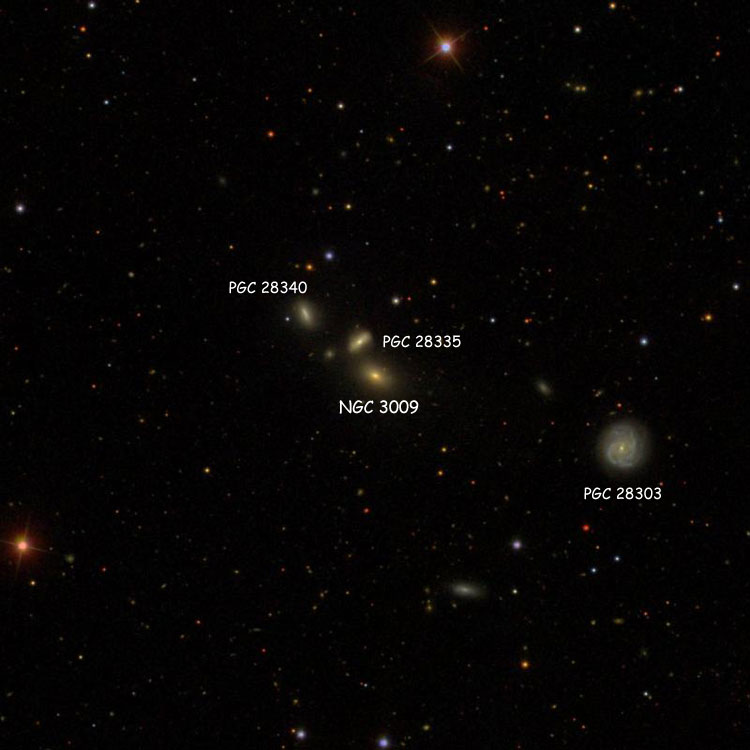
Above, a 12 arcmin wide region centered on NGC 3009, also showing PGC 28335, 28340 and 28303
Below, a 0.8 arcmin wide SDSS image of the galaxy

Below, a 12 arcmin wide simulation of what Herschel might have seen in the region near JH 640/641

Below, a labeled version of the image above

WORKING HERE (June 2+): title corrected, but discussion of historical identification still wrong
PGC 28303 (not = NGC 3009)
Not an NGC object but listed here because long misidentified as NGC 3009
Observed (Mar 1, 1854) by William Parsons, 3rd Lord Rosse, or by R. J. Mitchell
Also observed (Mar 17, 1895) by Guillaume Bigourdan
A magnitude 13.6 spiral galaxy (type SABbc?) in Ursa Major (RA 09 50 11.1, Dec +44 17 42)
Historical Identification: Per Dreyer, NGC 3009 (= GC 1933 = JH 640, 1860 RA 09 41 01, NPD 45 01.8) is "pretty faint, round, brighter middle, mottled but not resolved, preceding (western) of 2", the other being NGC 3010. The position precesses to RA 09 49 53.6, Dec +44 19 16, but there is nothing there. There are, however, a number of galaxies not far to the east of Herschel's position, and since NGC 3009 was recorded as being southwest of NGC 3010, the relatively bright galaxy (PGC 28303) to the southwest of the others was accepted as JH 640 well before the General Catalog was published, let alone the NGC. However, as noted by Corwin, Dreyer's right ascensions for NGC 3009 and 3010 differ by only 6 seconds of time, while the galaxies usually identified as those objects are separated by 24 seconds of time; and although Herschel's absolute positions are often off by large amounts, his relative positions are rarely that poor, especially when the objects are close to each other. More importantly, although PGC 28303 looks fairly large and bright in modern photographs, its core (which would have been the only part of it bright enough for Herschel to notice) has negligible size and brightness, and Herschel might have overlooked it, or taken it for merely a very faint star. As a result, it is quite possible (if not probable) that PGC 28303 is not JH 640. But the NGC represents not only the observations of original observers, but also those of later ones. And in a compendium of Birr Castle observations published in 1880 by Lawrence Parsons, 4th Lord Rosse, it states "(GC) 1933/1935, 1854, Mar. 1. One pretty bright, 6 arcmin east and a little north are two others very faint, about 3 arcmin apart east-west; several others round about". This means that either the 3rd Lord Rosse or his assistant, R. J. Mitchell, observed the region on Mar 1, 1854, and on the basis of their description, GC 1933 (= NGC 3009) must be PGC 28303, and GC 1935 (= NGC 3010) must be some combination of the stars and galaxies to its east (although the actual angles involved are 4 and 2 arcmin, instead of 6 and 3). So as early as 1854 the galaxy listed above was being treated as what became NGC 3009, and whether it was what Herschel observed or not, that is enough to consider its NGC identity certain.
Additional Discovery Notes: As an added example, Guillaume Bigourdan observed virtually every GC and NGC object visible from Paris in the late 1800's, and when he observed what he thought were NGC 3009 and 3010, his position for NGC 3009 fell right on PGC 28303, so its historical identification rests on very firm ground. The one thing I find strange is that given the 1854 observation described in Lord Rosse's papers, and Dreyer's position as an assistant to the 4th Lord Rosse when he started updating the General Catalog, I would have expected him to make some correction to Herschel's positions to better reflect the difference in the objects' right ascensions; and if he had done that, there would have been no question about the identification discussed in this entry.
Physical Information: Based on a recessional velocity of 4665 km/sec, PGC 28303 is about 215 million light years away. Given that and its apparent size of 0.85 by 0.8 arcmin, it is about 55 thousand light years across.

Above, a 12 arcmin wide SDSS image centered on PGC 28303, also showing PGC 28330, 28335 & 28340
Below, a 1.2 arcmin wide SDSS image of the galaxy

WORKING HERE June 3+ (including confirming the PGC designations)
NGC 3010's IDENTIFICATION IS A BIT OF A MESS, AND WILL BE DEALT WITH LATER
(namely, before I finish this page, but not immediately)
NGC 3010 (currently misidentified as PGC 28330; to be fixed ASAP)
Recorded (Mar 17, 1828) by John Herschel
Observed (Mar 1, 1854) by William Parsons, 3rd Lord Rosse or R. J. Mitchell
Also observed (Mar 17, 1895) by Guillaume Bigourdan
A magnitude 14.5 spiral galaxy (type S??) in Ursa Major (RA 09 50 33.2, Dec +44 18 52)
Historical Identification: Per Dreyer, NGC 3010 (= GC 1935 = JH 641, 1860 RA 09 41 07, NPD 45 00.3) is "faint, pretty suddenly brighter middle, partially resolved, some stars seen, following (eastern) of 2", the other being NGC 3009. The position precesses to RA 09 49 59.6, Dec +44 20 45,
(per Corwin, identification uncertain in some way)
Physical Information:
PGC 28335 = "NGC 3010A" A 14.6 magnitude spiral galaxy (type S??) RA 09 50 34.6, Dec +44 19 24 ??
PGC 28330 = "NGC 3010B" A 14.5 magnitude spiral galaxy (type S??) RA 09 50 33.2, Dec +44 18 52 ??
PGC 28340 = "NGC 3010C" A 15.0 magnitude spiral galaxy (type S??) RA 09 50 39.4, Dec +44 19 52 ??
NGC 3011 (= PGC 28259)
Discovered (Apr 21, 1886) by Lewis Swift
A magnitude 13.3 lenticular galaxy (type S0(r)a? pec) in Leo (RA 09 49 41.2, Dec +32 13 16)
Historical Identification: Per Dreyer, NGC 3011 (Swift list III (#47), 1860 RA 09 41 16, NPD 57 09.2) is "most extremely faint, extremely small, stellar". The position precesses to RA 09 49 32.4, Dec +32 11 52, about 2.3 arcmin southwest of the galaxy listed above, but the description fits and there is nothing else nearby, so the identification seems certain.
Physical Information: Based on a recessional velocity of 1545 km/sec, NGC 3011 is about 70 million light years away, in reasonable agreemeent with with a single redshift-independent distance estimate of 80 million light years. Given that and its apparent size of 0.9 by 0.65 arcmin, it is only about 20 thousand light years across. NGC 3011 is listed as a starburst galaxy.

Above, a 12 arcmin wide SDSS image centered on NGC 3011
Below, a 1.2 arcmin wide SDSS image of the galaxy

NGC 3012 (= PGC 28270)
Discovered (Apr 30, 1862) by Heinrich d'Arrest
A magnitude 13.5 elliptical galaxy (type E1?) in Leo Minor (RA 09 49 52.1, Dec +34 42 51)
Historical Identification: Per Dreyer, NGC 3012 (= GC 1938, d'Arrest, 1860 RA 09 41 32, NPD 54 38.7) is "very faint, pretty large, round, cometic" (that is, having the appearance of a faint comet). The position precesses to RA 09 49 54.8, Dec +34 42 20, only about 0.7 arcmin southeast of the galaxy listed above, the description fits and there is nothing comparable nearby, so the identification is certain.
Physical Information: Based on a recessional velocity of 11665 km/sec, a straightforward calculation indicates that NGC 3012 is about 545 million light years away. However, for objects at such distances we should take into account the expansion of the Universe during the time it took their light to reach us. Doing that shows that the galaxy was about 520 million light years away at the time the light by which we see it was emitted, about 520 million years ago (the difference between the two numbers being due to the expansion of the intervening space during the light-travel time). Given that and its apparent size of 1.2 by 1.1 arcmin, the galaxy is about 180 thousand light years across.

Above, a 12 arcmin wide SDSS image centered on NGC 3012
Below, a 1.5 arcmin wide SDSS image of the galaxy
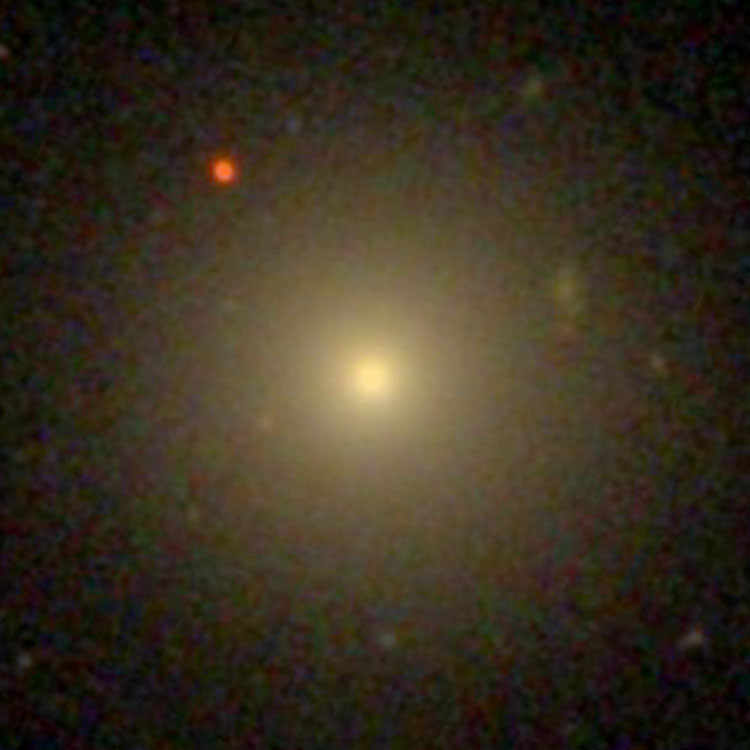
NGC 3013 (= PGC 28300)
Discovered (Mar 18, 1874) by Lawrence Parsons, 4th Earl of Rosse
Rediscovered (May 12, 1896) by Stephane Javelle
A magnitude 14.9 spiral galaxy (type (R)SABa(r)?) in Leo Minor (RA 09 50 09.4, Dec +33 34 10)
Historical Identification: Per Dreyer, NGC 3013 (= GC 5505, 4th Lord Rosse, 1860 RA 09 41 50, NPD 55 06.9) is "pretty faint, pretty small, round, brighter middle, h645 to east", h645 being NGC 3201.
The second IC states "NPD is 55 46.9", the blame for the error being attributed to a misprint (Dreyer's 1877 Supplement to the GC having correctly listed the NPD as 55 46.9). The corrected position precesses to RA 09 50 09.6, Dec +33 34 06, right on the galaxy listed above and the description fits, including its position relative to NGC 3201 (which is about 48 seconds of time due east), so the identification is certain.
Discovery Notes: Due to the misprint in the NGC, Javelle thought his #1127 was a new object, hence his inclusion in the list of observers even though his observation was not mentioned by Dreyer.
Physical Information: Based on a recessional velocity of 8090 km/sec, a straightforward calculation indicates that NGC 3013 is about 375 million light years away. However, for objects at such distances we should take into account the expansion of the Universe during the time it took their light to reach us. Doing that shows that the galaxy was about 365 million light years away at the time the light by which we see it was emitted, about 370 million years ago (the difference between the two numbers being due to the expansion of the intervening space during the light-travel time). Given that and its apparent size of 0.55 by 0.4 arcmin, the galaxy is about 60 thousand light years across.

Above, a 12 arcmin wide SDSS image centered on NGC 3013
Below, a 0.8 arcmin wide SDSS image of the galaxy

NGC 3014 (= PGC 28222 = PGC 1054062)
Discovered (Feb 19, 1830) by John Herschel
A magnitude 13.9 spiral galaxy (type SB(s)bc?) in Sextans (RA 09 49 07.6, Dec -04 44 35)
Historical Identification: Per Dreyer, NGC 3014 (= GC 1941 = JH 644, 1860 RA 09 42 03, NPD 94 03.6) is "extremely faint, pretty large, preceding (western) of 2", the other being NGC 3022. The position precesses to RA 09 49 05.3, Dec -04 42 33, just over 2 arcmin north northwest of the galaxy listed above, the description fits (including the position relative to NGC 3022, which is about 25 arcmin to the south and half a minute of time to the east) and there is nothing else nearby, so the identification is certain.
Physical Information: Based on a recessional velocity of 6305 km/sec, NGC 3014 is about 295 million light years away. Given that and its apparent size of 1.1 by 0.9 arcmin, it is about 130 thousand light years across.

Above, a 12 arcmin wide DSS image centered on NGC 3014
Below, a 1.5 arcmin wide DSS image of the galaxy

NGC 3015 (= PGC 28240)
Discovered (Apr 23, 1864) by Albert Marth
A magnitude 13.5 spiral galaxy (type SABbc?) in Sextans (RA 09 49 22.9, Dec +01 08 44)
Historical Identification: Per Dreyer, NGC 3015 (= GC 5506, Marth 183, 1860 RA 09 42 11, NPD 88 11) is "faint, very small, almost stellar". The position precesses to RA 09 49 24.0, Dec +01 10 01, about 1.3 arcmin north of the galaxy listed above, the description fits and there is nothing else nearby so the identification is certain.
Physical Information: Based on a recessional velocity of 7500 km/sec, a straightforward calculation indicates that NGC 3015 is about 350 million light years away. However, for objects at such distances we should take into account the expansion of the Universe during the time it took their light to reach us. Doing that shows that the galaxy was about 340 million light years away at the time the light by which we see it was emitted, about 345 million years ago (the difference between the two numbers being due to the expansion of the intervening space during the light-travel time). Given that and its apparent size of 0.7 by 0.45 arcmin, the galaxy is about 70 thousand light years across.
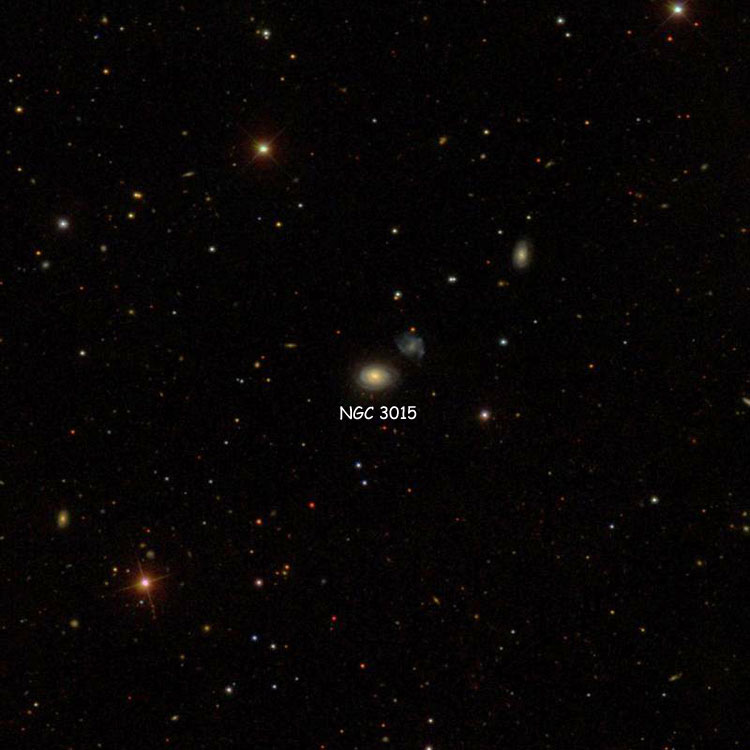
Above, a 12 arcmin wide SDSS image centered on NGC 3015
Below, a 0.9 arcmin wide SDSS image of the galaxy

NGC 3016 (= PGC 28269)
Discovered (Mar 21, 1854) by R. J. Mitchell
Also observed (Dec 31, 1864) by Heinrich d'Arrest
A magnitude 12.9 spiral galaxy (type Sb?) in Leo (RA 09 49 50.7, Dec +12 41 43)
Historical Identification: Per Dreyer, NGC 3016 (= GC 5507, d'Arrest, 3rd Lord Rosse, 1860 RA 09 42 15, NPD 76 39.4) is "very faint, small, round, preceding (western) of 2", the other being NGC 3019. The position precesses to RA 09 49 49.1, Dec +12 41 36, on the western rim of the galaxy listed above, the description fits (including the position relative to NGC 3019, which lies to the northeast) and there is nothing else nearby so the identification is certain.
Discovery Notes: Although Dreyer credits the report of the discovery to William Parsons, 3rd Earl of Rosse, he notes that many of Rosse's nebular discoveries were actually made by his assistants, George Stoney, Bindon Stoney and R. J. Mitchell.
Physical Information: Based on a recessional velocity of 8970 km/sec, a straightforward calculation indicates that NGC 3016 is about 420 million light years away, in fair agreement with redshift-independent distance estimates of 455 to 475 million light years. However, for objects at such distances we should take into account the expansion of the Universe during the time it took their light to reach us. Doing that shows that the galaxy was almost 405 million light years away at the time the light by which we see it was emitted, about 410 million years ago (the difference between the two numbers being due to the expansion of the intervening space during the light-travel time). Given that and its apparent size of 1.7 by 0.9 arcmin, the galaxy is about 200 thousand light years across.

Above, a 12 arcmin wide SDSS image centered on NGC 3016, also showing NGC 3019
Below, a 2 arcmin wide SDSS image of the galaxy
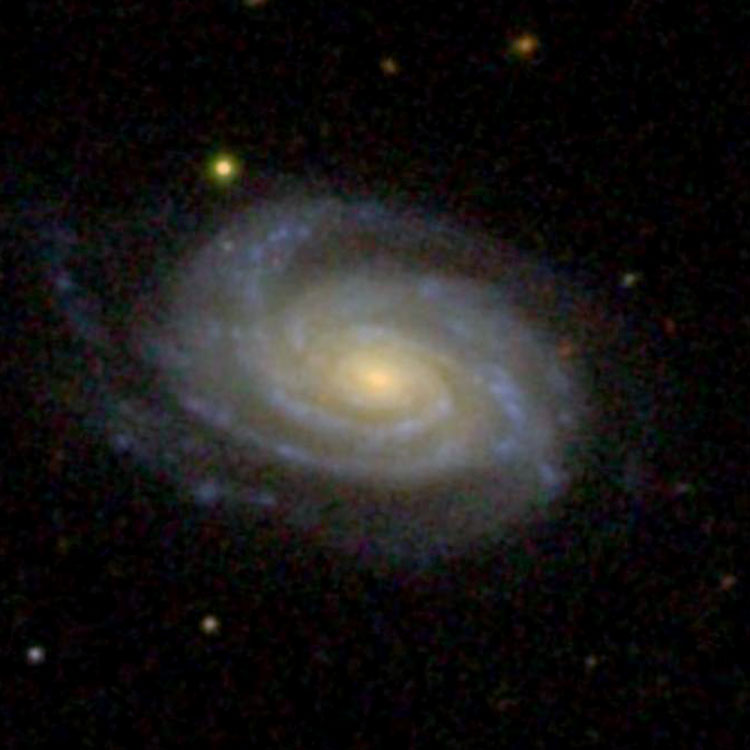
NGC 3017 (= PGC 28220)
Discovered (1886) by Ormond Stone
A magnitude 13.1 elliptical galaxy (type E1?) in Sextans (RA 09 49 03.0, Dec -02 49 19)
Historical Identification: Per Dreyer, NGC 3017 (O. Stone list II (#416), 1860 RA 09 42 17, NPD 92 12.7) is "extremely faint, very small, 11th magnitude star 3 arcmin to northwest". The position precesses to RA 09 49 22.7, Dec -02 51 41, nearly 5 1/2 arcmin southeast of the galaxy listed above, but there is nothing else nearby and the star to its northwest makes the identification certain.
Physical Information: Based on a recessional velocity of 6230 km/sec, NGC 3017 is about 290 million light years away. Given that and its apparent size of 1.1 by 1.0 arcmin, it is about 95 thousand light years across.
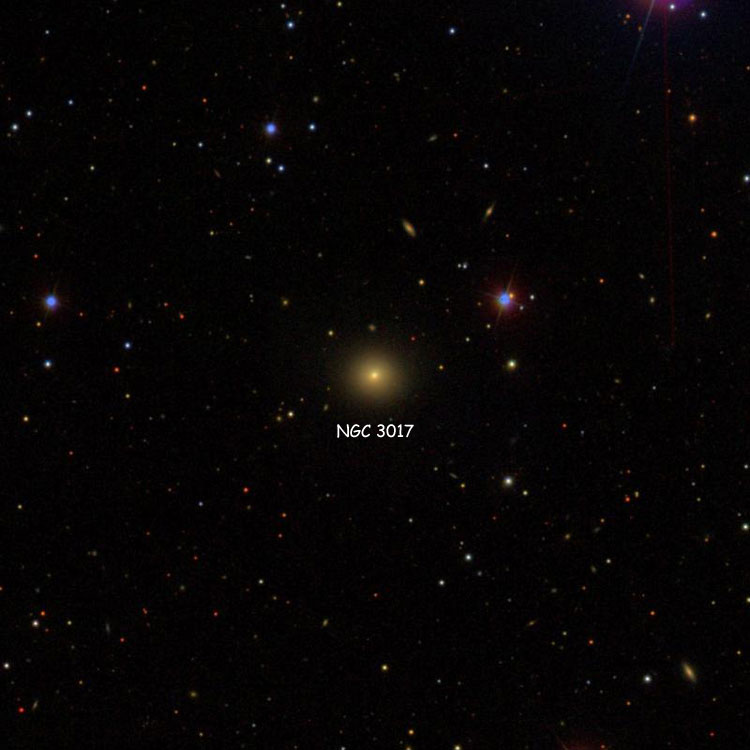
Above, a 12 arcmin wide SDSS image centered on NGC 3017
Below, a 1.6 arcmin wide SDSS image of the galaxy

NGC 3018 (= PGC 28258)
Discovered (Mar 10, 1880) by Édouard Stephan
Also observed (Mar 10, 1886) by Lewis Swift
A magnitude 13.3 spiral galaxy (type SB(s)b? pec) in Sextans (RA 09 49 41.5, Dec +00 37 19)
Historical Identification: Per Dreyer, NGC 3018 (Stephan list X (#21), Swift list III (#48), 1860 RA 09 42 29, NPD 88 43.6) is "very faint, very small, brighter middle" (Swift's description adds "western of two, star near to north", the other being NGC 3023). The position precesses to RA 09 49 41.0, Dec +00 37 23, right on the galaxy listed above, and the combination of Dreyer's and Swift's descriptions makes the identification certain.
Discovery Notes: Swift's position is well to the west of the galaxy listed above, but its position just west of NGC 3023 and the star immediately to its northwest perfectly match his description of the field, making its identification as Stephan's #21 and therefore NGC 3018 certain.
Physical Information: Based on a recessional velocity of 1865 km/sec, NGC 3018 is a little over 85 million light years away. Given that and its apparent size of 1.1 by 0.6 arcmin, it is about 25 thousand light years across. Its distorted appearance is presumably due to an interaction with NGC 3023, which is at essentially the same distance from us.

Above, a 12 arcmin wide SDSS image centered on NGC 3018, also showing NGC 3023
Below, a 1.5 arcmin wide SDSS image of the galaxy

NGC 3019 (= PGC 28295)
Discovered (Mar 21, 1854) by R. J. Mitchell
A magnitude 15.2 spiral galaxy (type Sbc?) in Leo (RA 09 50 07.2, Dec +12 44 46)
Historical Identification: Per Dreyer, NGC 3019 (= GC 1940, 3rd Lord Rosse, 1860 RA 09 42 30, NPD 76 39) is "extremely faint, following (eastern) of 2", the other being NGC 3016. The position precesses to RA 09 50 04.1, Dec +12 41 58, almost 3 arcmin south southwest of the galaxy listed above, but the description fits (including the position relative to NGC 3016, which lies to the southwest) and all the other galaxies in the region are accounted for by other entries, so the identification is certain.
Discovery Notes: Although Dreyer credits the report of the discovery to William Parsons, 3rd Earl of Rosse, he notes that many of Rosse's nebular discoveries were actually made by his assistants, George Stoney, Bindon Stoney and R. J. Mitchell.
Physical Information: Based on a recessional velocity of 8905 km/sec, a straightforward calculation indicates that NGC 3019 is about 415 million light years away. However, for objects at such distances we should take into account the expansion of the Universe during the time it took their light to reach us. Doing that shows that the galaxy was about 400 million light years away at the time the light by which we see it was emitted, about 405 million years ago (the difference between the two numbers being due to the expansion of the intervening space during the light-travel time). Given that and its apparent size of 0.75 by 0.4 arcmin, the galaxy is about 85 thousand light years across.

Above, a 12 arcmin wide SDSS image centered on NGC 3019, also showing NGC 3016, 3020 and 3024
Below, a 1 arcmin wide SDSS image of the galaxy

NGC 3020 (= PGC 28296)
Discovered (Mar 19, 1784) by William Herschel
Also observed (Mar 16, 1830) by John Herschel
A magnitude 11.9 spiral galaxy (type SB(r)cd? pec?) in Leo (RA 09 50 06.6, Dec +12 48 49)
Historical Identification: Per Dreyer, NGC 3020 (= GC 1942 = GC 1939 = JH 646 = JH 642 = WH III 51, 1860 RA 09 42 31, NPD 76 32.0) is "extremely faint, pretty small, a little extended 0°, mottled but not resolved". The position precesses to RA 09 50 05.3, Dec +12 48 58, right on the galaxy listed above, the description fits perfectly, and all the other galaxies in the region are accounted for by other entries, so the identification is certain.
Discovery Notes: In the NGC notes Dreyer states "h642 = h646 with an error of 1 minute in RA, as (JH) only observed the former in one sweep, in which h646 and 648 do not occur, and nothing was seen in Birr nor by d'Arrest in the place assigned to h642." This note is the basis for equating GC 1939 (= JH 642) with GC 1942 (= JH 646 = WH III 51), as shown in the NGC entry.
Physical Information: Based on a recessional velocity of 1440 km/sec, NGC 3020 is about 65 million light years away, in reasonable agreement with widely varying redshift-independent distance estimates of 70 to 155 million light years. Given that and its apparent size of 3.1 by 1.6 arcmin, it is about 60 thousand light years across.

Above, a 12 arcmin wide SDSS image centered on NGC 3020, also showing NGC 3019 and 3024
Below, a 3.6 arcmin wide SDSS image of the galaxy
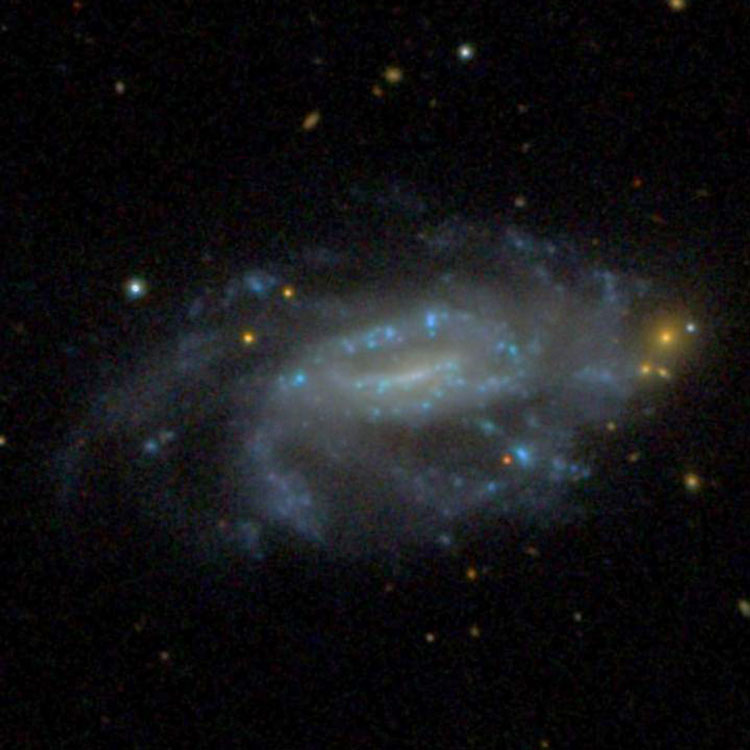
NGC 3021 (= PGC 28357)
Discovered (Dec 7, 1785) by William Herschel
Also observed (Jan 22, 1827) by John Herschel
Also observed (Feb 4, 1864) by Heinrich d'Arrest
A magnitude 12.1 spiral galaxy (type Sab?) in Leo Minor (RA 09 50 57.2, Dec +33 33 13)
Historical Identification: Per Dreyer, NGC 3021 (= GC 1944 = JH 645 = WH I 115, (d'Arrest), 1860 RA 09 42 38, NPD 55 47.7) is "pretty bright, pretty small, very little extended, much brighter middle, 10th magnitude star at 140°". The position precesses to RA 09 50 57.2, Dec +33 33 13, right on the galaxy listed above, the description fits, and the star to the southeast makes the identification certain.
Discovery Notes: In Dreyer's 1877 Supplement to the General Catalog he notes "1944: GC has a 10th magnitude star southeast at 100°, which does not agree with Phil. Trans. 1833 (20° southeast). According to d'Arrest the star is 4.4 seconds of time to the east, position 141°." Since this comment is the basis of "10th magnitude star at 140°" in the NGC entry, d'Arrest should have been mentioned in the NGC entry, hence my inclusion of his observation in parentheses.
Physical Information: Based on a recessional velocity of 1540 km/sec, NGC 3021 is about 70 million light years away, in good agreement with widely varying redshift-independent distance estimates of 50 to 115 million light years and in fair agreement with the most commonly quoted distance of about 100 million light years. Using a distance of 100 million light years for the galaxy and its apparent size of 1.45 by 0.85 arcmin, it is about 40 thousand light years across. (NED lists a second recessional velocity of 5305 km/sec, but that would correspond to a distance of about 245 million light years, so far beyond any reasonable distance estimate that it must be a misattribution of a redshift belonging to a different galaxy.)
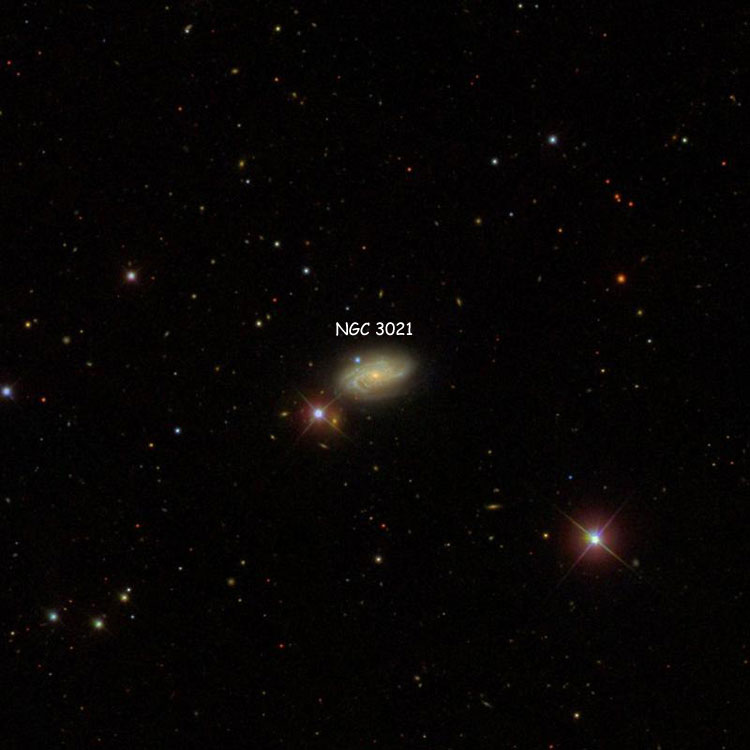
Above, a 12 arcmin wide SDSS image centered on NGC 3021
Below, a 1.5 arcmin wide SDSS image of the galaxy
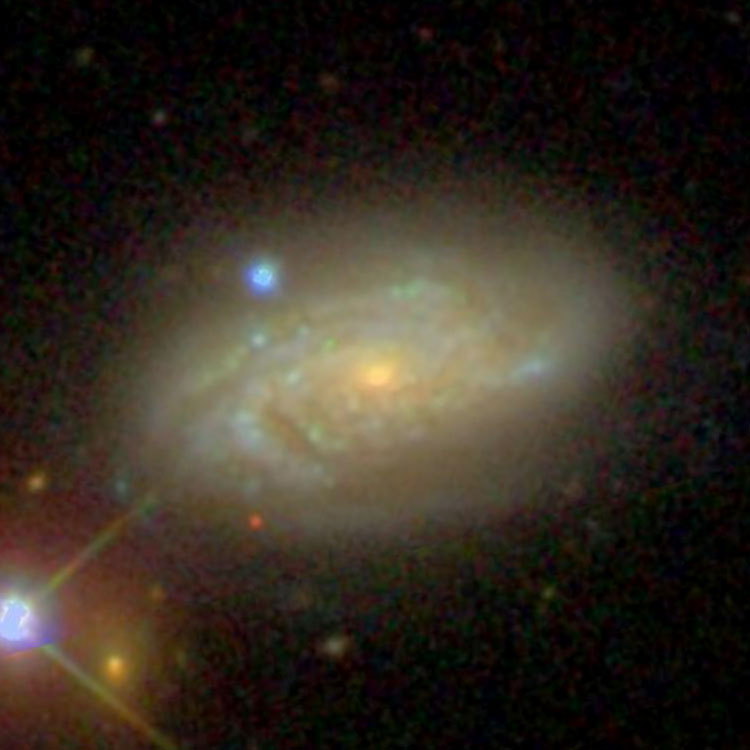
Below, a 1.2 by 1.8 arcmin wide image of the galaxy (rotated with North about eight degrees above left)
(Image Credit NASA/ESA, Acknowledgement: A. Riess (STScI))

NGC 3022 (= PGC 28257)
Discovered (Feb 19, 1830) by John Herschel
A magnitude 13.2 lenticular galaxy (type (R)S0?) in Sextans (RA 09 49 39.2, Dec -05 09 59)
Historical Identification: Per Dreyer, NGC 3022 (= GC 1943 = JH 647, 1860 RA 09 42 39, NPD 94 31.2) is "faint, round, very gradually a little brighter middle, following (eastern) of 2", the other being NGC 3014. The position precesses to RA 09 49 40.5, Dec -05 10 13, on the southeastern rim of the galaxy listed above, the description fits (including the position relative to NGC 3014, which is about 25 arcmin to the north and half a minute of time to the west) and there is nothing comparable nearby, so the identification is certain.
Physical Information: Based on a recessional velocity of 6255 km/sec, NGC 3022 is about 290 million light years away. Given that and its apparent size of 1.7 by 1.7 arcmin, it is about 145 thousand light years across.

Above, a 12 arcmin wide DSS image centered on NGC 3022
Below, a 2.4 arcmin wide DSS image of the galaxy
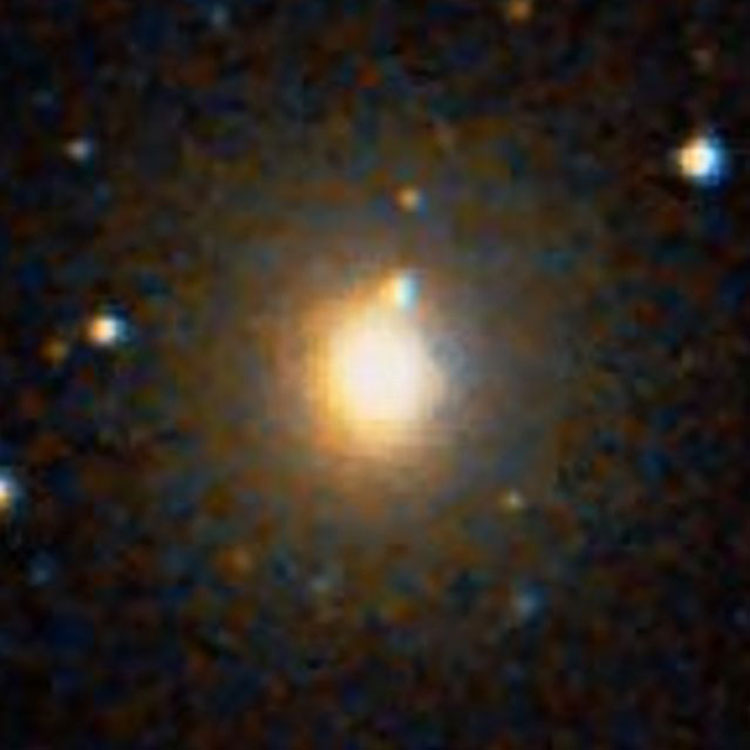
NGC 3023 (= PGC 28272 (includes PGC 28275 and "PGC 3518618"))
Discovered (Mar 10, 1880) by Édouard Stephan
Also observed (Mar 10, 1886) by Lewis Swift
A magnitude 12.3 spiral galaxy (type SAB(s)bc? pec) in Sextans (RA 09 49 52.6, Dec +00 37 08)
Historical Identification: Per Dreyer, NGC 3023 (Stephan list X (#22), Swift list III (#49), 1860 RA 09 42 41, NPD 88 43.7) is "pretty faint, pretty large, irregularly round, a little brighter middle, diffuse" (Swift's paper adds "eastern of 2", the other being NGC 3018). The position precesses to RA 09 49 53.0, Dec +00 37 16, right on the galaxy listed above, the description fits (including the relative position noted by Swift) and there is nothing else nearby save for Swift's "western of 2" (the aforementioned NGC 3018), so the identification is certain.
Physical Information: Based on a recessional velocity of 1880 km/sec, NGC 3023 is almost 90 million light years away, in good agreement with redshift-independent distance estimates of 90 to 110 million light years. Given that and its apparent size of 2.8 by 1.2 arcmin (including its extended arms), it is about 70 thousand light years across. Its distorted appearance is presumably due to an interaction with NGC 3018, which is at essentially the same distance from us. LEDA lists the bright emission region on the eastern side of NGC 3023 as a supposedly separate galaxy (PGC 28275), and the "pair" is listed as PGC 3518618 (though a search of LEDA for that designation returns no result).

Above, a 12 arcmin wide SDSS image centered on NGC 3023, also showing NGC 3018
Below, a 3.2 arcmin wide SDSS image of the galaxy
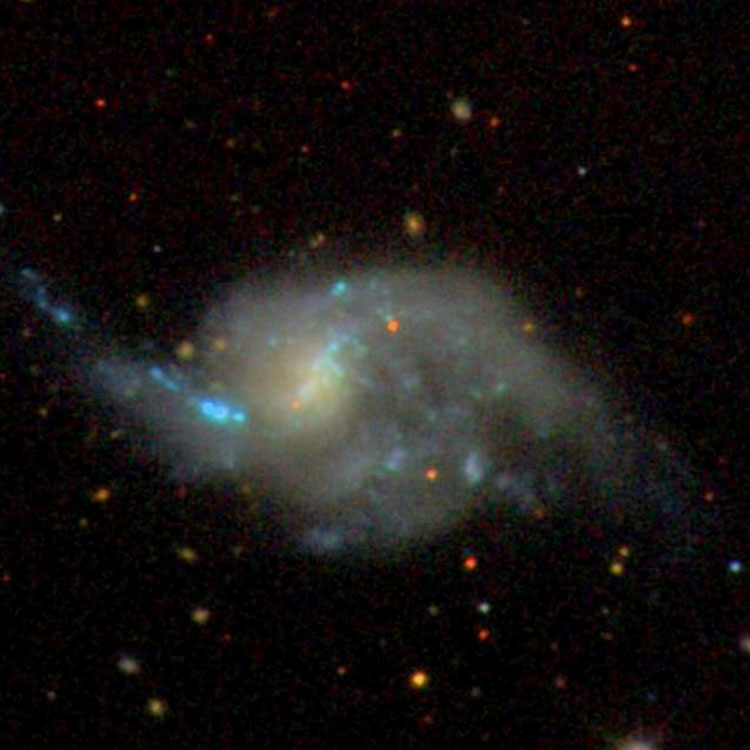
NGC 3024 (= PGC 28324)
Discovered (Mar 19, 1784) by William Herschel
Also observed (Mar 23, 1830) by John Herschel
A magnitude 13.1 spiral galaxy (type Sc? pec?) in Leo (RA 09 50 27.4, Dec +12 45 56)
Historical Identification: Per Dreyer, NGC 3024 (= GC 1945 = JH 648 = WH III 52, 1860 RA 09 42 54, NPD 76 36.3) is "extremely faint, pretty large, extended, mottled but not resolved". The position precesses to RA 09 50 28.1, Dec +12 44 37, only 1.4 arcmin south of the galaxy listed above, the description fits perfectly and there is nothing else nearby that is not already accounted for, so the identification is certain.
Physical Information: Based on a recessional velocity of 1415 km/sec, NGC 3024 is about 65 million light years away. Given that and its apparent size of 2.2 by 0.65 arcmin, it is about 40 thousand light years across.

Above, a 12 arcmin wide SDSS image centered on NGC 3024, also showing NGC 3019 and 3020
Below, a 2.8 arcmin wide SDSS image of the galaxy

NGC 3025 (= PGC 28249 = PGC 824313)
Discovered (Mar 21, 1835) by John Herschel (3192)
A magnitude 12.9 lenticular galaxy (type SA0? pec?) in Hydra (RA 09 49 29.1, Dec -21 44 32)
Historical Identification: Per Dreyer, NGC 3025 (= GC 1946 = JH 3192, 1860 RA 09 42 58, NPD 111 05.3) is "extremely faint, very small, round, 9th magnitude star to south". The position precesses to RA 09 49 27.8, Dec -21 44 20, on the western rim of the galaxy listed above, there is nothing else nearby and the star to the southeast makes the identification certain.
Physical Information: Based on a recessional velocity of 8505 km/sec, a straightforward calculation indicates that NGC 3025 is about 395 million light years away. However, for objects at such distances we should take into account the expansion of the Universe during the time it took their light to reach us. Doing that shows that the galaxy was about 385 million light years away at the time the light by which we see it was emitted, about 390 million years ago (the difference between the two numbers being due to the expansion of the intervening space during the light-travel time). Given that and its apparent size of 1.8 by 1.2 arcmin, the galaxy is about 200 thousand light years across.

Above, a 12 arcmin wide SDSS image centered on NGC 3025
Below, a 2 arcmin wide SDSS image of the galaxy

NGC 3026 (= PGC 28351)
Discovered (May 22, 1886) by Lewis Swift
A magnitude 12.9 spiral galaxy (type SAB(r)dm?) in Leo (RA 09 50 55.3, Dec +28 33 04)
Historical Identification: Per Dreyer, NGC 3026 (= Swift list III (#50), 1860 RA 09 42 58, NPD 60 49.1) is "most extremely faint, pretty small, a little extended, very difficult". The position precesses to RA 09 51 04.8, Dec +28 31 47, about 2.5 arcmin southeast of the galaxy listed above, but the description fits and there is nothing else nearby so the identification is certain.
Physical Information: Based on a recessional velocity of 1490 km/sec, NGC 3026 is about 70 million light years away, in good agreement with redshift-independent distance estimates of 50 to 90 million light years. Given that and its apparent size of 2.7 by 0.65 arcmin, it is about 55 thousand light years across. NGC 3026 is usually classified as an irregular galaxy, but its nucleus is surrounded by a ring of star-forming regions that suggests it is more likely to be a poorly organized spiral galaxy.

Above, a 12 arcmin wide SDSS image centered on NGC 3026
Below, a 3.2 arcmin wide SDSS image of the galaxy
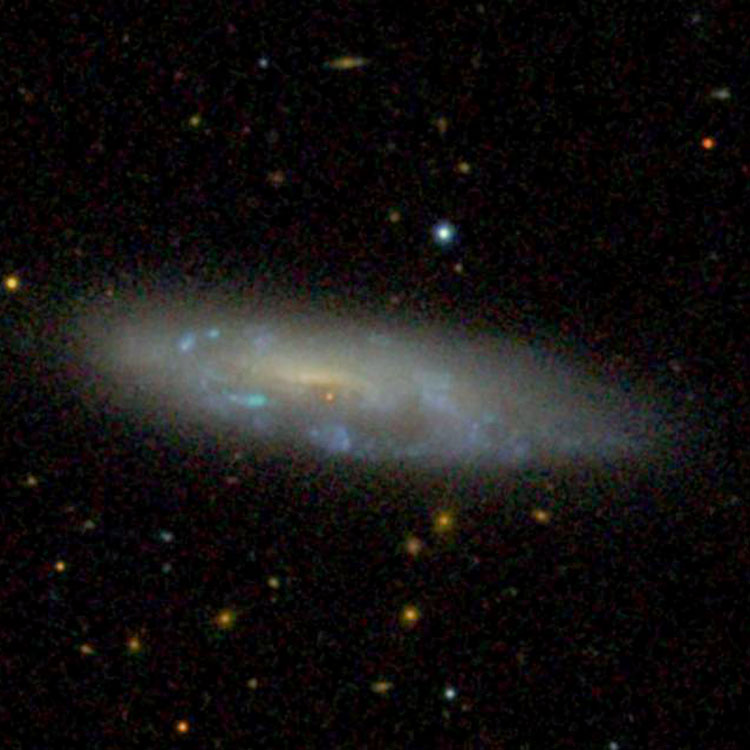
NGC 3027 (= PGC 28636)
Discovered (Apr 3, 1785) by William Herschel
Also observed (Nov 4, 1831) by John Herschel
A magnitude 11.8 spiral galaxy (type SB(s)bc? pec?) in Ursa Major (RA 09 55 40.6, Dec +72 12 13)
Historical Identification: Per Dreyer, NGC 3027 (= GC 1947 = JH 643 = WH V 23, 1860 RA 09 43 10, NPD 17 08.4) is "very faint, very large, a little extended, mottled but not resolved". The position precesses to RA 09 55 40.9, Dec +72 12 13, right on the galaxy listed above, the description fits and there is nothing else nearby, so the identification is certain.
Physical Information: Based on a recessional velocity of 1060 km/sec, NGC 3027 is about 50 million light years, in reasonable agreement with redshift-independent distance estimates of 55 to 80 million light years. Given that and its apparent size of 4.2 by 1.5 arcmin, the galaxy is about 60 thousand light years across.
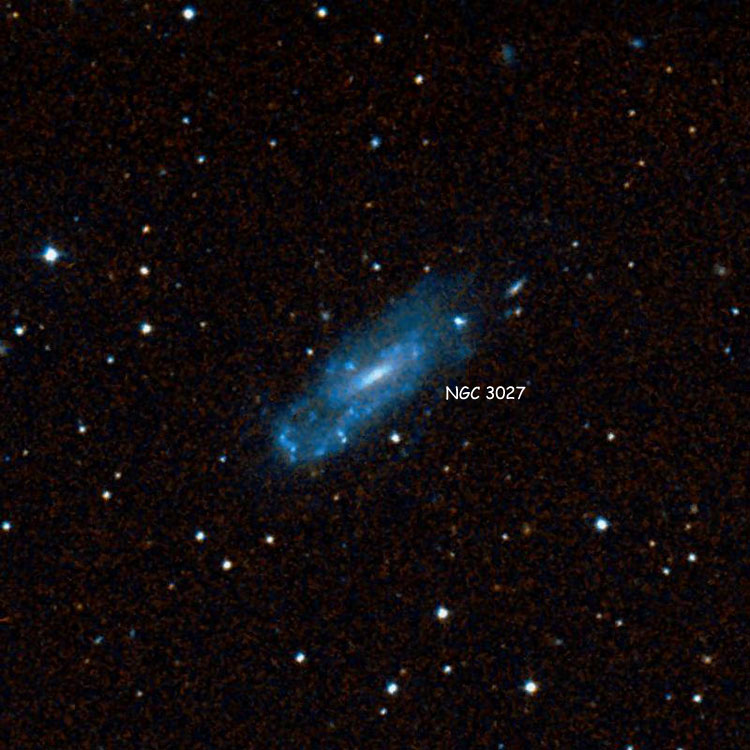
Above, a 12 arcmin wide DSS image centered on NGC 3027
Below, a 4.5 arcmin wide DSS image of the galaxy
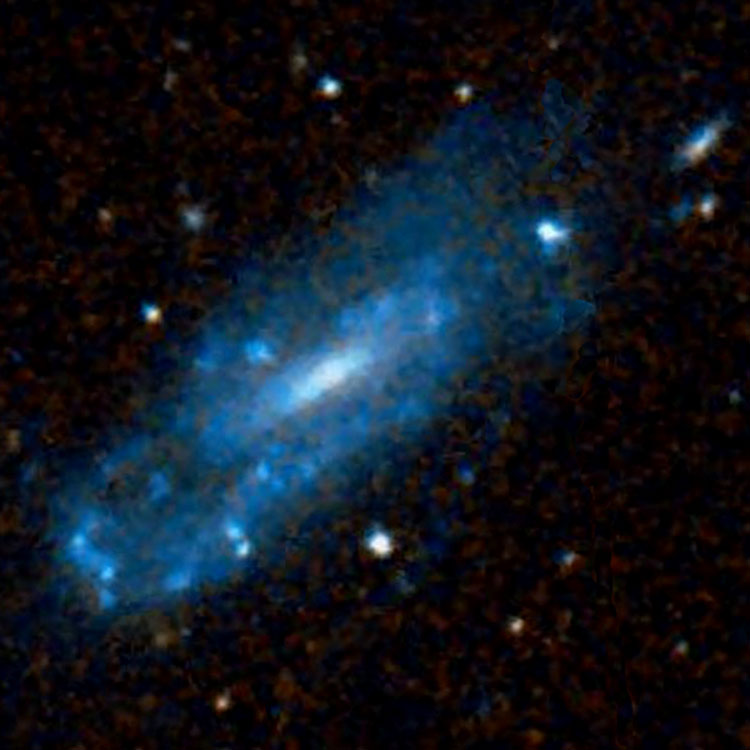
NGC 3028 (= PGC 28276)
Discovered (Mar 23, 1835) by John Herschel
A magnitude 12.9 spiral galaxy (type Sb? pec) in Hydra (RA 09 49 54.3, Dec -19 11 03)
Historical Identification: Per Dreyer, NGC 3028 (= GC 1948 = JH 3913, 1860 RA 09 43 18, NPD 108 31.6) is "faint, small, round, a little brighter middle". The position precesses to RA 09 49 53.2, Dec -19 10 40, barely off the northwestern rim of the galaxy listed above, the description fits and there is nothing else nearby so the identification is certain.
Physical Information: Based on a recessional velocity of 4045 km/sec, NGC 3028 is about 190 million light years away, in good agreement with redshift-independent distance estimates of 180 to 195 million light years. Given that and its apparent size of 0.85 by 0.6 arcmin, it is about 45 thousand light years across.

Above, a 12 arcmin wide DSS image centered on NGC 3028
Below, a 1 arcmin wide DSS image of the galaxy
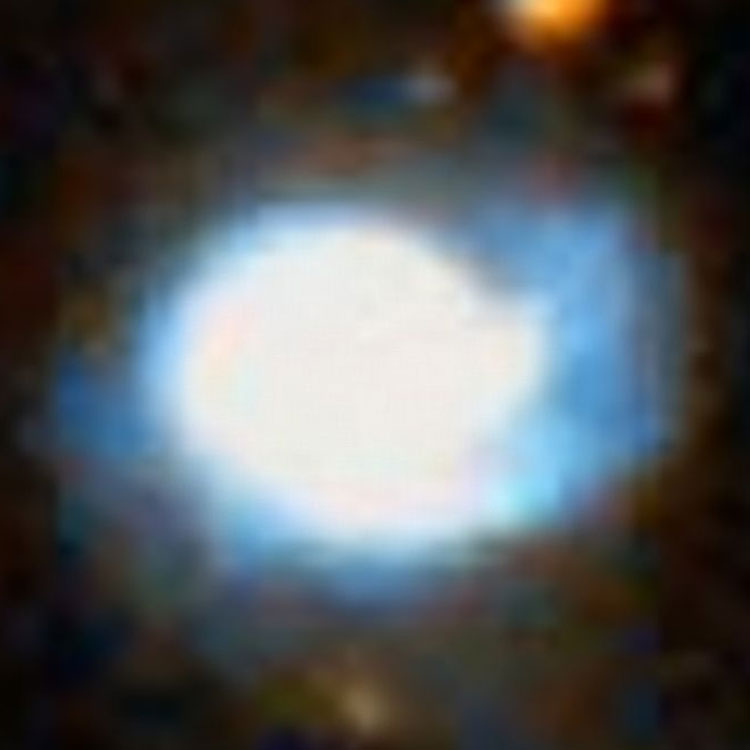
NGC 3029 (probably = PGC 28206)
Discovered (Feb 8, 1886) by Lewis Swift
A magnitude 14.0 spiral galaxy (type SAB(r)c?) in Sextans (RA 09 48 54.0, Dec -08 03 04)
Historical Identification: Per Dreyer, NGC 3029 (Swift list III (#51), 1860 RA 09 43 26, NPD 97 17.4) is "pretty faint, pretty small, round". The position precesses to RA 09 50 22.5, Dec -07 56 30, in a completely stellar region. I cannot find anything about when the galaxy listed above was first suggested as being what Swift observed (though see the Additional Note below), but it is the only nebular obect within a degree-wide region centered on his position and its appearance fits his description, so although its position is a minute and a half of time to the west and 6 1/2 arcmin to the south of his published position it is not an unreasonable choice, particularly since Swift's method of observation sometimes produced large errors in his positions. Namely, he used a very wide field of view without any crosshairs, making it difficult to accurately center his "novae" in the eyepiece, then (usually) climbed down a ladder to read the setting circles on the telescope. Despite this rough method he often obtained good results, but many of his positions were off even more than this one, presuming the identification is correct. And since no one appears to have offered any alternatives or objections, it is probably as good a choice as any.
Additional Note: The NED notes that the MCG (the Morphological Catalog of Galaxies by Vorontsov-Velyaminov et al.) listed the right ascension of the galaxy a minute of time larger than the correct value; since that would make the difference between the recorded position of the galaxy and the NGC position only half a minute of time, the MCG might be the source of the first modern identification of this galaxy as NGC 3029.
Physical Information: Based on a recessional velocity of 6530 km/sec, PGC 28206 is about 305 million light years away, in reasonable agreement with redshift-independent distance estimates of 215 to 295 million light years. Given that and its apparent size of 1.35 by 0.9 arcmin, the galaxy is about 120 thousand light years across.

Above, a 12 arcmin wide DSS image centered on NGC 3029
Below, a 1.5 arcmin wide DSS image of the galaxy

NGC 3030 (= PGC 28302)
Discovered (1886) by Francis Leavenworth
Also observed (Jul 1, 1898 to Jun 30, 1899) by Herbert Howe
A magnitude 13.3 lenticular galaxy (type E/S0?) in Hydra (RA 09 50 10.6, Dec -12 13 35)
Historical Identification: Per Dreyer, NGC 3030 (Leavenworth list II (#417), 1860 RA 09 43 32, NPD 101 35.7) is "extremely faint, very small, round, brighter middle". The second IC lists a corrected RA (per Howe) of 09 43 21. The corrected position precesses to RA 09 50 09.6, Dec -12 14 47, about 1.2 arcmin south of the galaxy listed above, the description fits and there is nothing else nearby so the identification is certain.
Physical Information: Based on a recessional velocity of 2705 km/sec, NGC 3030 is about 125 million light years away. Given that and its apparent size of 0.75 by 0.75 arcmin, it is about 25 thousand light years across.
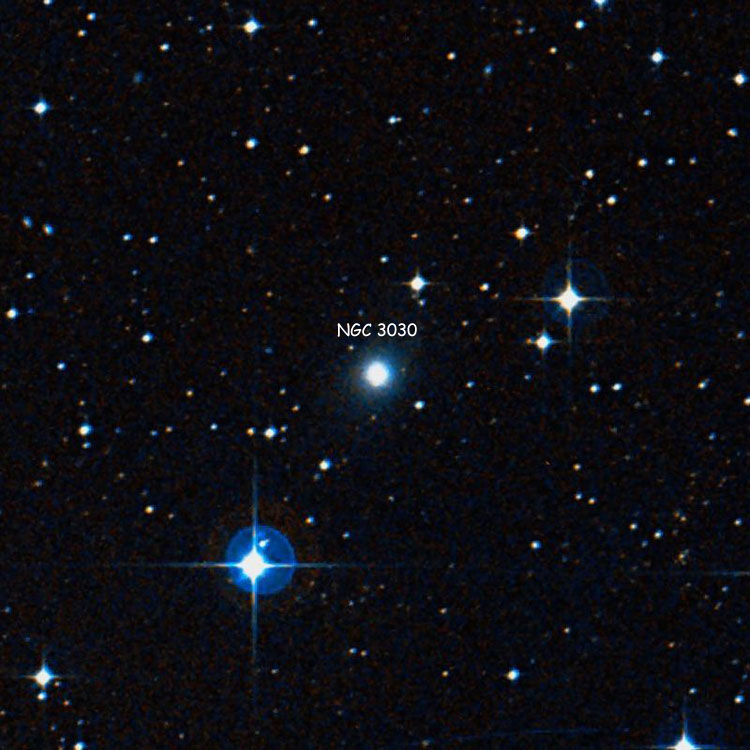
Above, a 12 arcmin wide DSS image centered on NGC 3030
Below, a 1.2 arcmin wide DSS image of the galaxy

NGC 3031 (= M81= PGC 28630), and with NGC 3034 = Bode's Nebulae
Discovered (Dec 31, 1774) by Johann Bode
Discovered (1772 - 78) and recorded (1779) by Johann Koehler (#8a)
Rediscovered (August 1780) by Pierre Méchain
Observed (Feb 9, 1781) by Charles Messier and recorded as M81
Also observed (Aug 6, 1783) by William Herschel
Also observed (Oct 28, 1831) by John Herschel
A magnitude 6.9 spiral galaxy (type SA(s)ab?) in Ursa Major (RA 09 55 33.2, Dec +69 03 55)
Historical Identification: Per Dreyer, NGC 3031 (= GC 1949 = GC 1953 = JH 649, Bode (17), M81, 1860 RA 09 43 56, NPD 20 16.7) is "a remarkable object, extremely bright, extremely large, extended 156°, gradually then suddenly very much brighter middle and bright nucleus". The position precesses to RA 09 55 34.1, Dec +69 30 53, right on the galaxy listed above, the description fits and there is nothing else nearby so the identification is certain.
Discovery Notes: Koehler's note to Bode (dated Aug 1, 1779) listed a number of objects observed by him between 1772 and 1778. Nothing appears to be available concerning when Koehler observed M81 and M82 (the pair being #8 in his list), but since Bode had already recorded his discovery of the objects nearly five years before receiving Koehler's note, it is generally presumed that Bode made the earliest observation of the nebulae bearing his name.
William Herschel's Observations: Usually, Dreyer's NGC entries place observations by William Herschel in a column reserved for them, but in the case of NGC 3031 there is no such reference, implying that William did not see the nebula. However, he did make several observations of M81, and the inclusion of GC 1953 is an indirect reference to an observation by Herschel (unfortunately, incorrectly interpreted by his son John in preparing the GC), so it is appropriate to discuss the elder Herschel's observations,and why are apparently ignored in the NGC. The main reason is that in general, Herschel did not list Messier objects in his published papers, and his observation of 1783 (shown above) is only recorded in his logbook 6, and three observations made between 1801 and 1810 in later logbooks (though the later observations were described in notes by Dreyer in the 1912 publication The Scientific Papers of Sir William Herschel). And because of positional errors made by both Herschels, when John Herschel published his General Catalog he ended up with three entries for the two galaxies in the region: GC 1949 (which is M81), GC 1950 (which is M82) and GC 1953, which did not appear to correspond to any object (it actually lies on the northern rim of M81 in modern photographs, but the galaxies look much smaller with visual observations such as those made by the Herschels, so it would have seemed a completely different object at the time). As a result, John Herschel added a note suggesting that GC 1953 was not a third nebula but a poorly measured observation of M81, and Dreyer adopted that suggestion in his 1877 Supplement to the General Catalog, stating "1953: To be struck out, as suspected p.23, GC. Not seen by anybody after (William Herschel), is therefore = M81". This is the basis of the equality GC 1949 = GC 1953 in the NGC entry, and my statement that GC 1953 represents an indirect reference to William Herschel's observations.
Even in the 1912 publication noted above Herschel's first observation of M81 was ignored, and the only reference to it (other than in the original logbook 6) appears to be a paper by Wolfgang Steinicke, which is an exhaustive account of the Herschels' observations of M81 and M82 and my source for the date of William Herschel's first observation of M81. That first observation was made with a 12-inch mirror, causing the stars near the nebula to appear more obvious than the nebulosity, while WH's second observation (on Nov 8, 1801) was made with an 18-inch mirror, allowing the nebulous nature of the object to be far better displayed; as a result the 1801 observation is often considered the first true observation of the nebula by Herschel, even though he had looked at the same region 18 years earlier.
Physical Information: The negative (-35 km/sec) radial velocity of M81 is obviously too affected by its peculiar (non-Hubble expansion) velocity to be of any use in estimating its distance. Redshift-independent distance estimates range from 4.5 to 16.5 million light years, with the most commonly quoted distance being about 12 million light years. Given that and its apparent size of 22 by 12 arcmin, the galaxy is about 75 thousand light years across. M81 is gravitationally bound to and interacting with M82 (see M81 and M82: A Cosmic Near Miss for more information).
Importance to Astrometry (the Measurement of Astronomical Positions): M81 contains a strong point radio source near its center (presumably related to a supermassive black hole in its core), and (per Corwin) being one of the few close bright galaxies with such a radio source, is one of the reference points for the International Celestial Reference System, which provides the basis for determining positions in the sky. In that way it is of fundamental importance in determining the positions of all celestial objects (reference systems being useless without accurate reference points).

Above, a 24 arcmin wide SDSS image centered on NGC 3031, also showing PGC 28757, a satellite of M81
Below, a 12 by 18 arcmin wide image of the galaxy (Image Credit ESA, Hubble Heritage Team (STScI/AURA), NASA)

NGC 3032 (= PGC 28424)
Discovered (Dec 24, 1827) by John Herschel
A magnitude 12.5 spiral galaxy (type (R)SA(rs)a? pec) in Leo (RA 09 52 08.2, Dec +29 14 10)
Historical Identification: Per Dreyer, NGC 3032 (= GC 1951 = JH 650, 1860 RA 09 44 00, NPD 60 06.6) is "faint, small, suddenly brighter middle equivalent to 12th magnitude star, between 2 bright stars". The position precesses to RA 09 52 08.0, Dec +29 14 10, right on the galaxy listed above, the description fits perfectly and there is nothing else nearby so the identification is certain.
Physical Information: Based on a recessional velocity of 1560 km/sec, NGC 3032 is about 75 million light years away, in reasonable agreement with wildly varying redshift-independent distance estimates of 5 to 140 million light years (and the same as the most commonly accepted estimate of 75 million light years). Given that and its apparent size of 2.1 by 1.5 arcmin, it is about 45 thousand light years across.

Above, a 12 arcmin wide SDSS image centered on NGC 3032
Below, a 2.4 arcmin wide SDSS image of the galaxy

Below, a closeup of the galaxy's core shows its spiral structure (Image Credit Hubble Legacy Archive)

NGC 3033 (= OCL 796 = "PGC 3518277")
Discovered (Feb 27, 1835) by John Herschel
A magnitude 8.8 open cluster (II3p) in Vela (RA 09 48 40.2, Dec -56 24 43)
Historical Identification: Per Dreyer, NGC 3033 (= GC 1952 = JH 3194, 1860 RA 09 44 02, NPD 145 45.7) is a "cluster, pretty large, pretty rich, irregular figure, stars from 11th to 12th magnitude". The position precesses to RA 09 48 39.0, Dec -56 24 45, almost exactly on the 6th magnitude star (HD 85250) that is considered the center of the cluster listed above, and though the cluster does not stand out against the background of the Milky Way in modern photographs, the identification is considered certain.
Physical Information: NGC 3033 is a moderately loose collection of about 50 brighter and probably considerably more fainter stars. Based on an estimated distance of 3000 light years and an apparent size of about 12 arcmin, the cluster is about 10 light years across. NGC 3033 is listed (as a cluster) as PGC 3518277 in LEDA, but a search of the database for that designation fails to return any result.

Above, a 15 arcmin wide DSS image centered on NGC 3033
WORKING HERE
(finish precession/historical identification, add physical information, more images)
NGC 3034 (= M82 = PGC 28655), and with NGC 3031 = Bode's Nebulae
Discovered (Dec 31, 1774) by Johann Bode
Discovered (1772 - 78) and recorded (1779) by Johann Koehler (#8b)
Rediscovered (August 1780) by Pierre Méchain
Observed (Feb 9, 1781) by Charles Messier and recorded as M82
Also observed (Sep 30, 1802) by William Herschel
A magnitude 8.4 spiral galaxy (type Scd? pec) in Ursa Major (RA 09 55 52.5, Dec +69 40 47)
Historical Identification: Per Dreyer, NGC 3034 (= GC 1950, WH IV 79 = 4 HON, Bode (18), M82, 1860 RA 09 44 10, NPD 19 38.7) is "very bright, very large, very much extended (ray)". (see Corwin)
Discovery Notes: Koehler's note to Bode (dated Aug 1, 1779) listed a number of objects observed by him between 1772 and 1778. Nothing appears to be available concerning when Koehler observed M81 and M82 (the pair being #8 in his list), but since Bode had already recorded his discovery of the objects nearly five years before receiving Koehler's note, it is generally presumed that Bode made the earliest observation of the nebulae bearing his name.
Herschel's IV 79 = 4 HON: This is one of eight objects observed by William Herschel but not published in the Philosophical Transactions; instead, they are listed by John Herschel in an Appendix on page 128 of his Cape of Good Hope observations. The note for this object reads "A very bright, beautiful ray of light about 8' long, 2' or 3' broad; brightest in the middle of all its lengths. Follows 27 Ursae (G. 1563) 14m 12s, and is 2° 27' south of that star. Discovered Sept. 30, 1802." The elder Herschel's last published entry for this class of object was IV 78, so HON 4 was assigned the designation IV 79.
Physical Information: Gravitationally bound to and interacting with M81. See M81 and M82: A Cosmic Near Miss for more information. Apparent size of about 9.4 by 5.75 arcmin, including the clouds of gas and dust ejected from the nucleus (from the images below).
 Above, an 18 arcmin wide SDSS image centered on NGC 3034 (= M82) Above, an 18 arcmin wide SDSS image centered on NGC 3034 (= M82)
Below, a 12 arcmin wide image of the galaxy
 Below, a 7.75 by 6.5 arcmin wide image of the galaxy (North at top) (Image Credit NASA/ESA Below, a 7.75 by 6.5 arcmin wide image of the galaxy (North at top) (Image Credit NASA/ESA
/Hubble Heritage (STScI/AURA), M. Mountain (STScI), P. Puxley (NSF), J. Gallagher (U. Wisconsin))
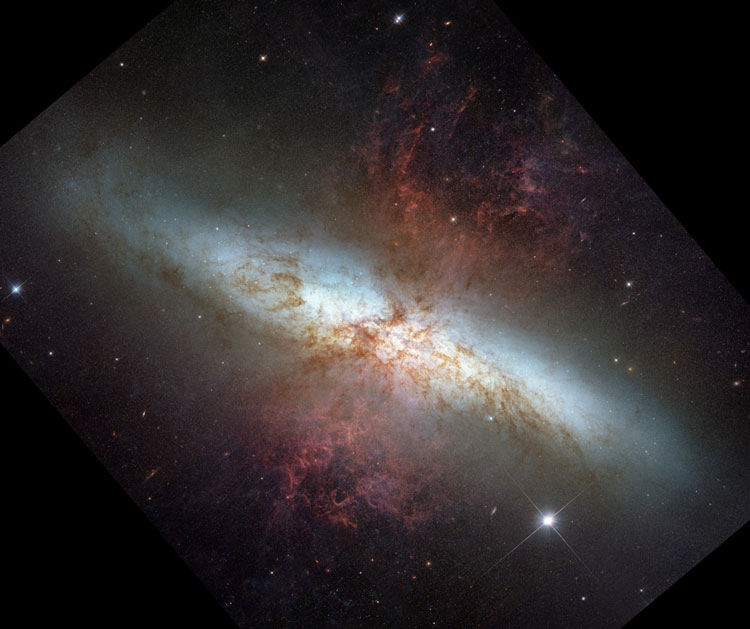
Below, a 5.75 by 8.25 arcmin wide image of the galaxy emphasizing material ejected from the nucleus
(North on upper right to allow for more detail. Image Credit as for image above; post-processing by Courtney Seligman)
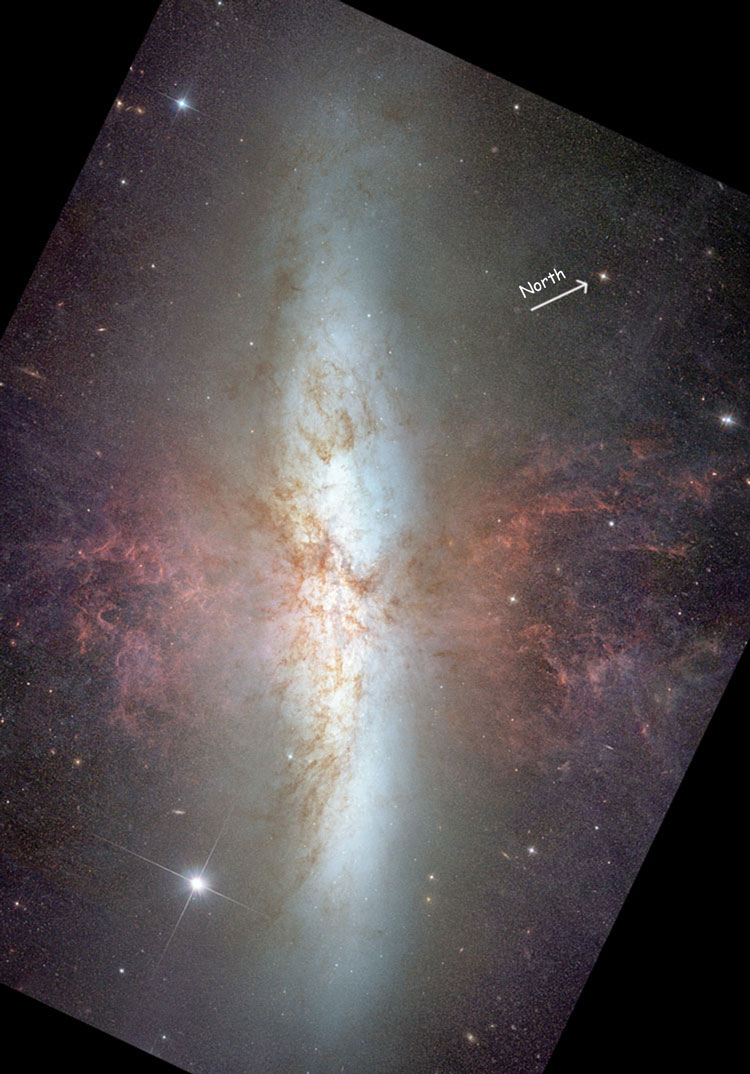
NGC 3035 (= PGC 28415)
Discovered (Mar 5, 1880) by Édouard Stephan
A magnitude 12.4 spiral galaxy (type SB(rs)bc?) in Sextans (RA 09 51 55.0, Dec -06 49 23)
Historical Identification: Per Dreyer, NGC 3035 (Stephan list X (#23), 1860 RA 09 44 56, NPD 96 10.2) is "pretty faint, pretty large, round, several very faint stars involved". The position precesses to RA 09 51 54.7, Dec -06 49 28, right on the galaxy listed above and there is nothing else nearby, so the identification is certain.
Physical Information: Based on a recessional velocity of 4355 km/sec, NGC 3035 is about 205 million light years away. Given that and its apparent size of 1.5 by 1.2 arcmin, it is about 105 thousand light years across. Listed as a Seyfert galaxy (type Sy 1.8).

Above, a 12 arcmin wide DSS image centered on NGC 3035
Below, a 1.8 arcmin wide DSS image of the galaxy
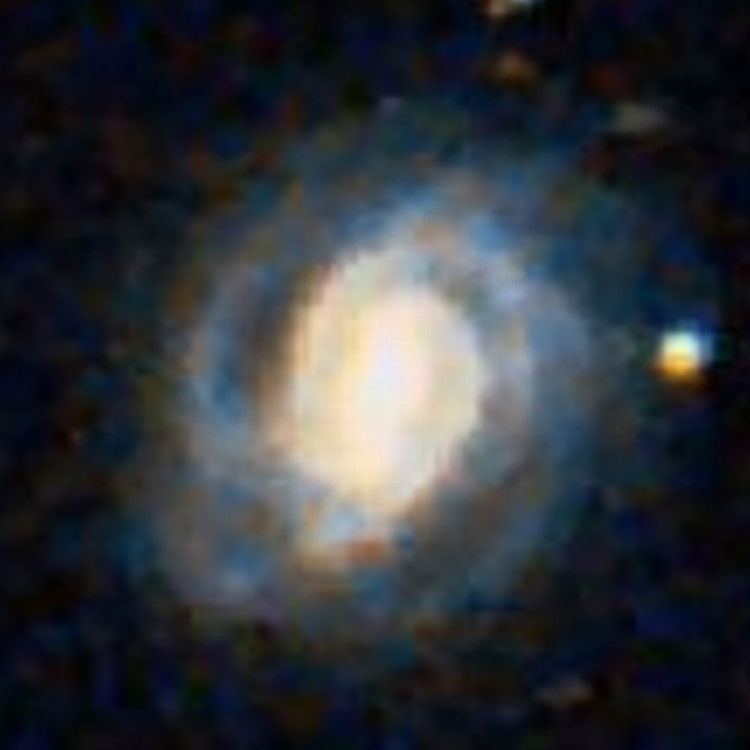
NGC 3036 (= "PGC 3518278")
Discovered (Mar 7, 1837) by John Herschel
An open cluster in Carina (RA 09 49 23, Dec -62 41 00)
Historical Identification: Per Dreyer, NGC 3036 (= GC 1954 = JH 3197, 1860 RA 09 45 06, NPD 152 02.2) is a "cluster, considerably large, a little compressed". The position precesses to RA 09 49 00.4, Dec -62 41 20, on the western rim of the cluster listed above, and although its irregular outline makes its actual center and extent uncertain, there is no doubt that it must be what Herschel observed.
Physical Information: NGC 3036 is an irregular scattering of a few dozen 10th to 12th magnitude stars, most obvious in a 7 by 3 arcmin wide region running east and west (which, given Herschel's description as "considerably large", almost certainly represents "his" cluster), but possibly including most of the brighter stars in the image below (in which case its center would be about an arcmin to the south). There appear to have been no studies of the region that could determine which of the multitude of stars in the region are members of the cluster, so its distance and physical size are unknown. Listed in LEDA as an unknown type of object with designation PGC 3518278, but a search of the database for that designation returns no result.

Above, a 12 arcmin wide DSS image centered on NGC 3036
NGC 3037 (= PGC 28381)
Discovered (Mar 26, 1835) by John Herschel
A magnitude 13.0 spiral galaxy (type SBm? pec?) in Hydra (RA 09 51 24.2, Dec -27 00 40)
Historical Identification: Per Dreyer, NGC 3037 (= GC 1955 = JH 3195, 1860 RA 09 45 06, NPD 116 22.1) is "faint, pretty small, round, a little brighter middle". The position precesses to RA 09 51 25.1, Dec -27 01 21, only 0.7 arcmin south southeast of the galaxy listed above and there is nothing else nearby, so the identification is certain.
Physical Information: Based on a recessional velocity of 885 km/sec, NGC 3037 is about 40 million light years away. Given that and its apparent size of 1.2 by 1.0 arcmin, it is about 15 thousand light years across, making it comparable in size and structure to the Large Magellanic Cloud.
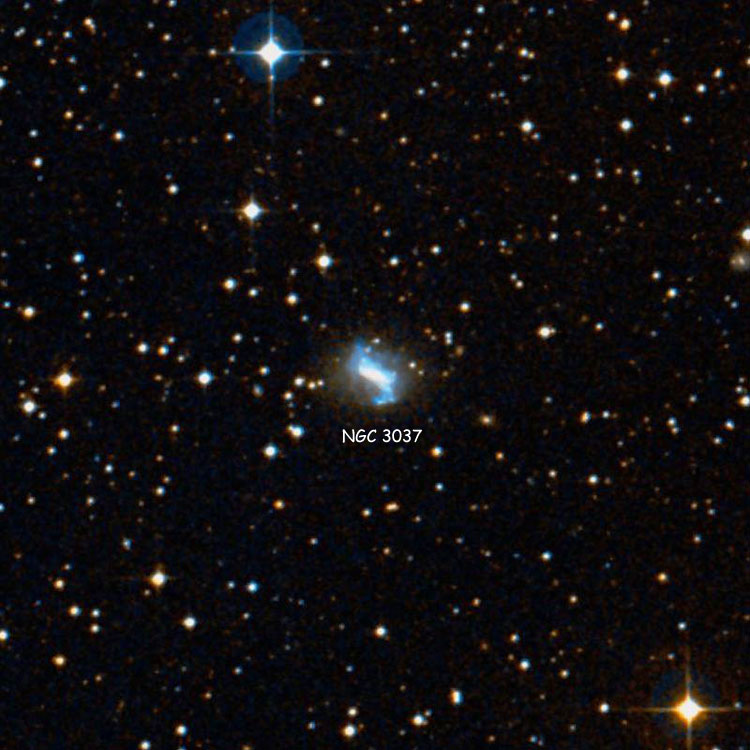
Above, a 12 arcmin wide DSS image centered on NGC 3037
Below, a 1.6 arcmin wide DSS image of the galaxy
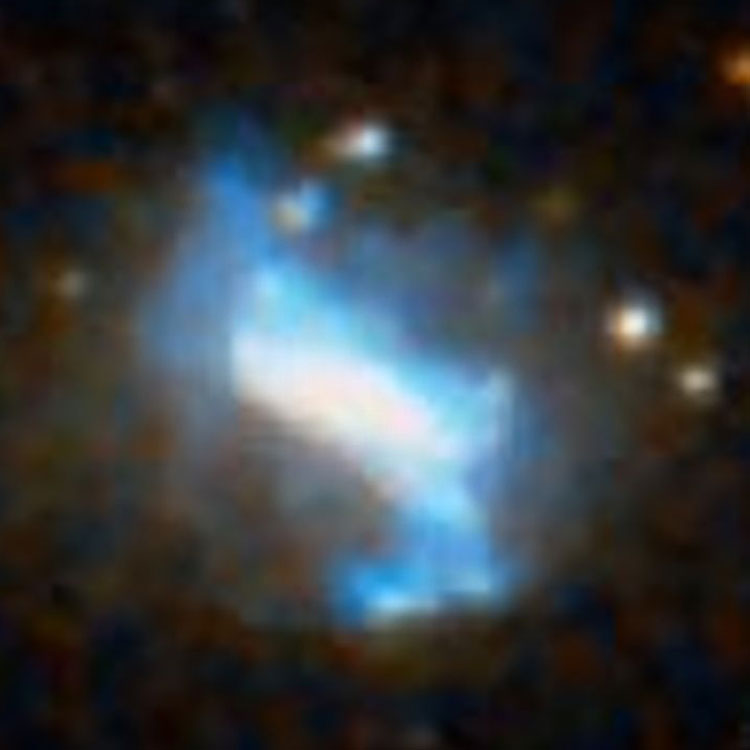
NGC 3038 (= PGC 28376 = PGC 686673)
Discovered (Feb 27, 1886) by Lewis Swift
A magnitude 11.6 spiral galaxy (type SA(rs)b?) in Antlia (RA 09 51 15.5, Dec -32 45 09)
Historical Identification: Per Dreyer, NGC 3038 (Swift list III (#52), 1860 RA 09 45 10, NPD 122 06.6) is "pretty bright, pretty small, round". The position precesses to RA 09 51 15.6, Dec -32 45 51, on the southern rim of the galaxy listed above and there is nothing else nearby, so the identification is certain.
Physical Information: Based on a recessional velocity of 2790 km/sec, NGC 3038 is about 130 million light years away, in good agreement with redshift-independent distance estimates of 80 to 145 million light years. Given that and its apparent size of 3.7 by 2.0 arcmin, it is about 140 thousand light years across.
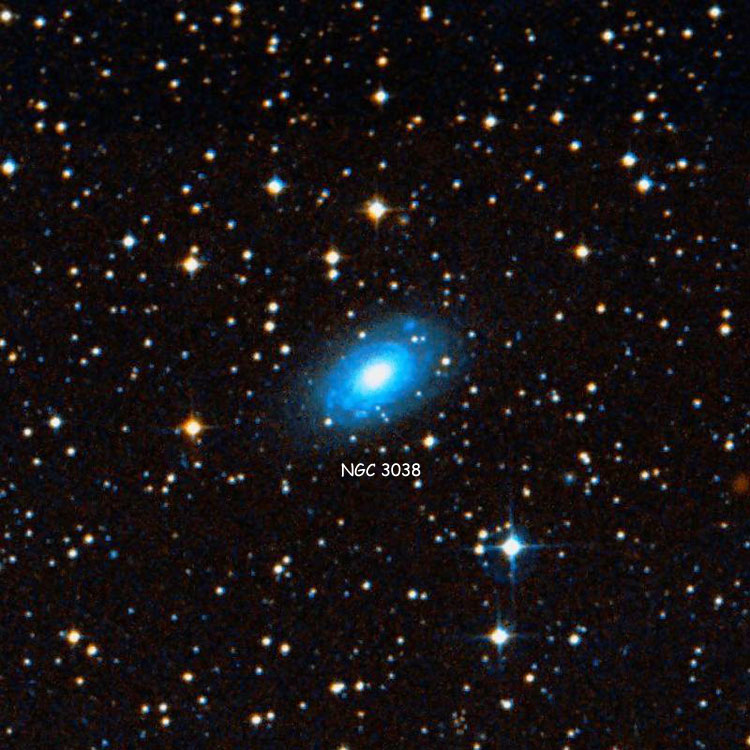
Above, a 12 arcmin wide DSS image centered on NGC 3038
Below, a 3.6 by 3 arcmin wide image of the galaxy
(Image Credit & © Carnegie-Irvine Galaxy Survey; used by permission)
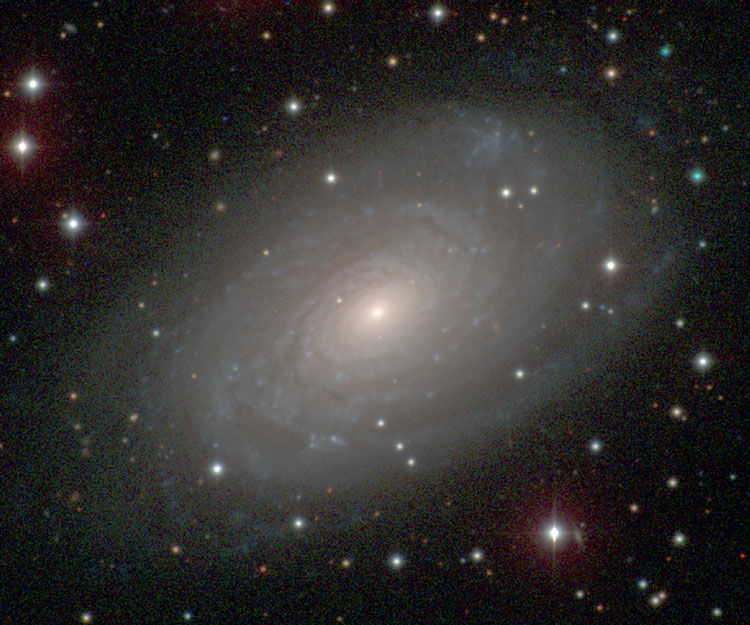
NGC 3039 (= PGC 28452 = PGC 1217722)
Discovered (Jan 22, 1865) by Albert Marth
A magnitude 13.4 spiral galaxy (type (R)SAB(s)b?) in Sextans (RA 09 52 29.7, Dec +02 09 16)
Historical Identification: Per Dreyer, NGC 3039 (= GC 5508, Marth 184, 1860 RA 09 45 12, NPD 87 12) is "very faint, small, irregularly round". The position precesses to RA 09 52 26.6, Dec +02 08 41, only about 0.9 arcmin southwest of the galaxy listed above, the description fits and there is nothing else nearby so the identification is certain.
Physical Information: Based on a recessional velocity of 5005 km/sec, NGC 3039 is about 235 million light years away, in good agreement with redshift-independent distance estimates of 210 to 245 million light years. Given that and its apparent size of 1.1 by 0.55 arcmin, it is about 75 thousand light years across.
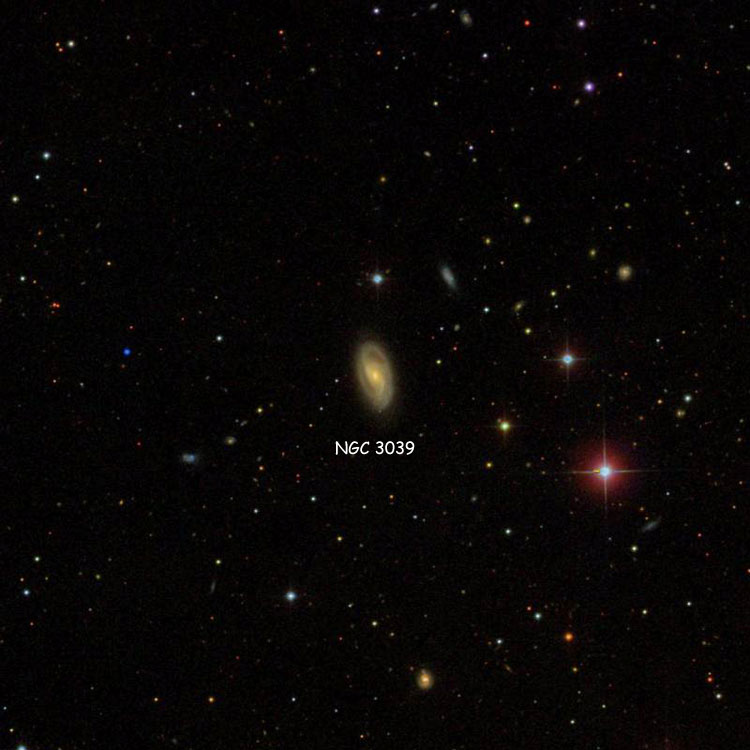
Above, a 12 arcmin wide SDSS image centered on NGC 3039
Below, a 1.4 arcmin wide SDSS image of the galaxy
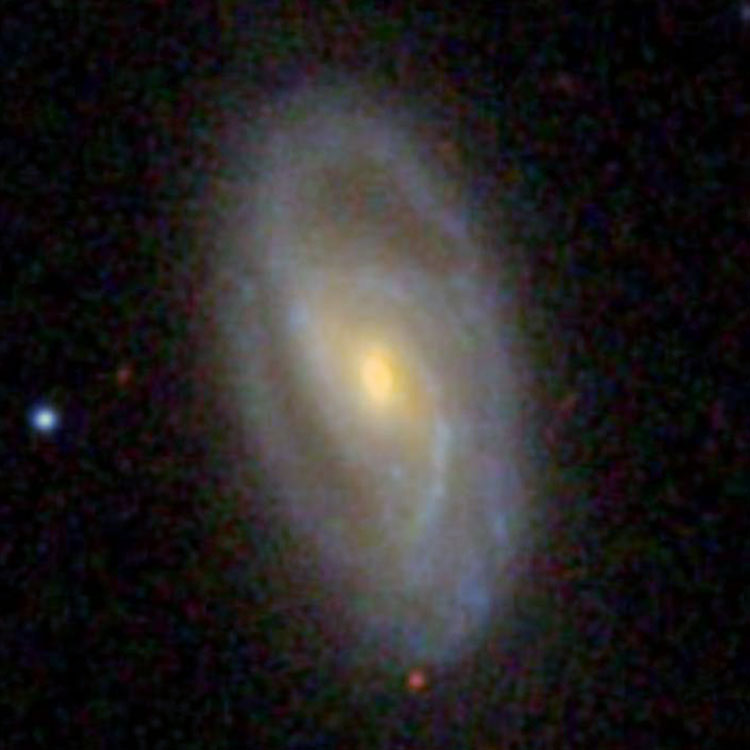
NGC 3040 (= PGC 28479)
Discovered (Mar 25, 1884) by Édouard Stephan
A magnitude 13.4 lenticular galaxy (type S0(r)a?) in Leo (RA 09 53 05.1, Dec +19 25 56)
Historical Identification: Per Dreyer, NGC 3040 (Stephan list XIII (#53), 1860 RA 09 45 18, NPD 69 54.7) is "very faint, very small, brighter middle, mottled but not resolved". The position precesses to RA 09 53 04.5, Dec +19 25 57, on the western rim of the galaxy listed above and there is nothing comparable nearby so the identification is certain. Per Corwin, PGC 28479 and PGC 200252 are listed in Holmberg's 1937 catalog of double galaxies (as #148), but only the brightest of the three galaxies in the region has a nucleus bright enough to have been seen by Stephan, so it alone comprises NGC 3040.
Physical Information: Based on a recessional velocity of 7615 km/sec, a straightforward calculation indicates that NGC 3040 is about 355 million light years away. However, for objects at such distances we should take into account the expansion of the Universe during the time it took their light to reach us. Doing that shows that the galaxy was about 345 million light years away at the time the light by which we see it was emitted, about 350 million years ago (the difference between the two numbers being due to the expansion of the intervening space during the light-travel time). Given that and its apparent size of 0.9 by 0.55 arcmin, the galaxy is about 90 thousand light years across. Although NGC 3040 was listed as a pair with PGC 200252, the more than 600 km/sec difference in the galaxies' radial velocities means it is unlikely that they really are a pair, and they certainly cannot be a gravitationally bound pair even if they happen to be closer than their different recessional velocities would imply. Instead, they are almost certainly an optical double.
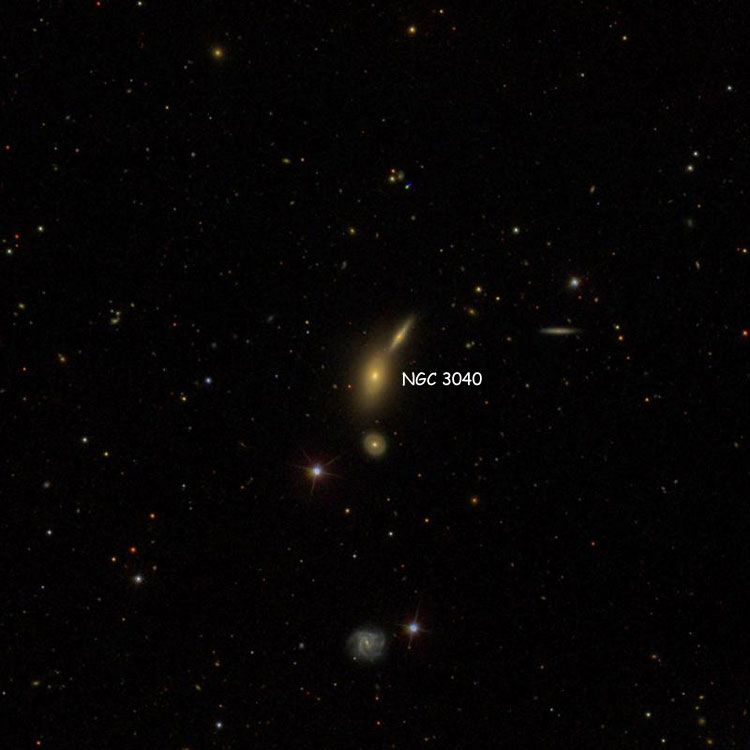
Above, a 12 arcmin wide SDSS image centered on NGC 3040
Below, a 1 arcmin wide SDSS image of the galaxy, also showing part of PGC 200252

Below, a 12 arcmin wide SDSS image centered on NGC 3040, also showing several PGC objects
(Currently labeled: PGC 28480, PGC 200252 and PGC 1591421)
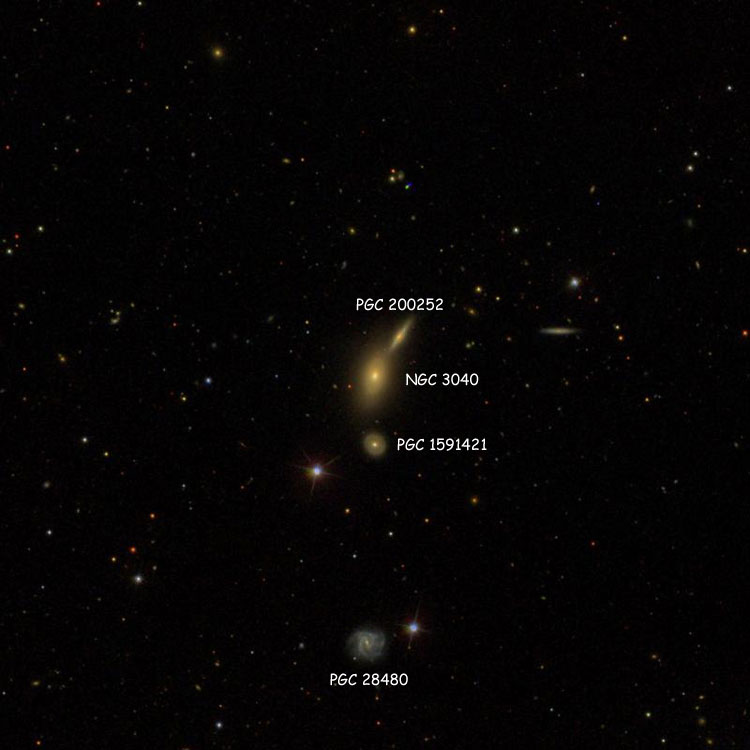
PGC 200252 (= "NGC 3040B")
Not an NGC object but listed here since sometimes called NGC 3040B
A magnitude 15.0 spiral galaxy (type Sb?) in Leo (RA 09 53 03.5, Dec +19 26 33)
Historical Identification: As noted in the discussion of NGC 3040, only that galaxy has a nucleus bright enough for Stephan to have seen, so although PGC 200252 is sometimes called NGC 3040B it actually has nothing to do with the NGC entry.
Physical Information: Based on a recessional velocity of 6975 km/sec, a straightforward calculation indicates that PGC 200252 is about 325 million light years away. However, for objects at such distances we should take into account the expansion of the Universe during the time it took their light to reach us. Doing that shows that the galaxy was about 315 million light years away at the time the light by which we see it was emitted, about 320 million years ago (the difference between the two numbers being due to the expansion of the intervening space during the light-travel time). Given that and its apparent size of 0.65 by 0.15 arcmin, the galaxy is about 60 thousand light years across. Although (as noted by Corwin) PGC 200252 was listed by Holmberg (in his 1937 catalog of double galaxies) as a pair with NGC 3040, the more than 600 km/sec difference in the galaxies' radial velocities means it is unlikely that they really are a pair (as they are separated by 30 million light years if their radial velocities reflect their distances), and they certainly cannot be a gravitationally bound pair even if they happen to be closer than their recessional velocities would imply (because such a large peculiar (non-Hubble expansion) velocity would mean they wouldn't have enough gravity to remain a physical pair). Instead, they are almost certainly an optical double.
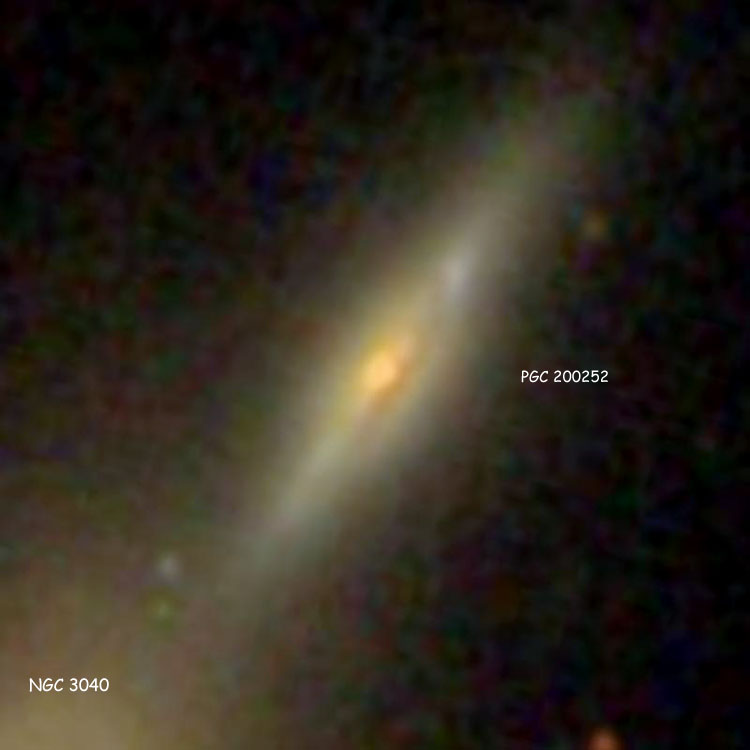
Above, a 0.8 arcmin wide SDSS image of PGC 200252 (see NGC 3040 for a wide-field image)
NGC 3041 (= PGC 28485)
Discovered (Mar 23, 1784) by William Herschel
Also observed (Mar 18, 1836) by John Herschel
A magnitude 11.5 spiral galaxy (type SAB(rs)bc?) in Leo (RA 09 53 07.1, Dec +16 40 40)
Historical Identification: Per Dreyer, NGC 3041 (= GC 1956 = JH 3196 = WH II 98, 1860 RA 09 45 25, NPD 72 40.1) is "a globular cluster, faint, large, round, very gradually a little brighter middle, partially resolved, some stars seen, 2 bright stars to southwest". The position precesses to RA 09 53 06.2, Dec +16 40 32, right on the galaxy listed above, there is nothing else nearby and the description fits (presuming that the misidentification as a globular cluster was due to the faint foreground stars superimposed on the galaxy), so the identification is certain.
Physical Information: Based on a recessional velocity of 1410 km/sec, NGC 3041 is about 65 million light years away, in good agreement with redshift-independent distance estimates of 45 to 90 million light years. Given that and its apparent size of 3.8 by 2.1 arcmin, it is about 70 thousand light years across.

Above, a 12 arcmin wide SDSS image centered on NGC 3041
Below, a 4 arcmin wide SDSS image of the galaxy
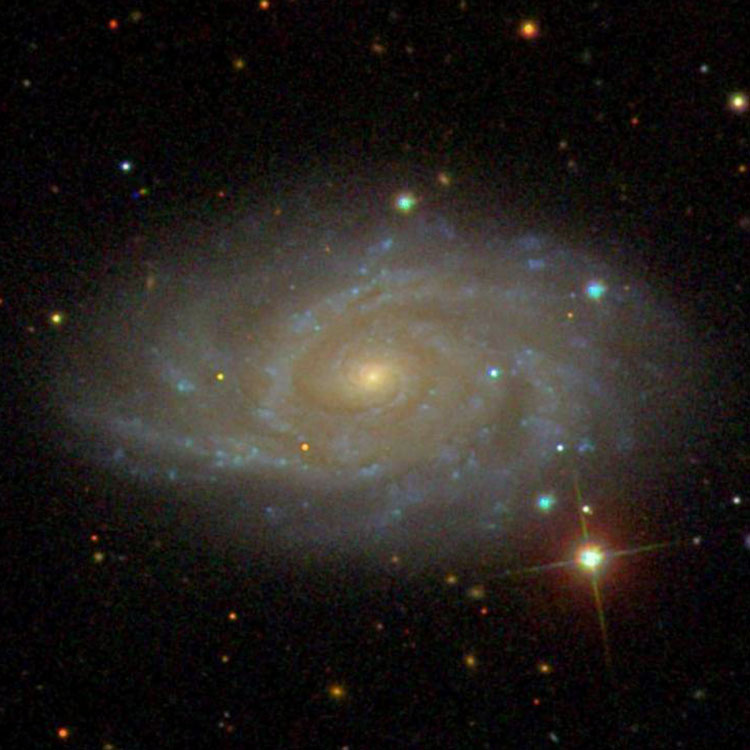
Below, a 2.3 by 2.2 arcmin wide image of part of the galaxy (Image Credit Hubble Legacy Archive)

NGC 3042 (= PGC 28498)
Discovered (Apr 30, 1864) by Albert Marth
A magnitude 12.9 spiral galaxy (type Sab?) in Sextans (RA 09 53 20.2, Dec +00 41 52)
Historical Identification: Per Dreyer, NGC 3042 (= GC 5509, Marth 185, 1860 RA 09 46 07, NPD 88 39) is "pretty bright, small, very little extended, gradually brighter middle". The position precesses to RA 09 53 19.1, Dec +00 41 35, only a third of an arcmin southwest of the galaxy listed above, the description fits and there is nothing else nearby so the identification is certain.
Physical Information: Based on a recessional velocity of 3855 km/sec, NGC 3042 is about 180 million light years away. Given that and its apparent size of 1.05 by 0.45 arcmin, it is about 55 thousand light years across.

Above, a 12 arcmin wide SDSS image centered on NGC 3042
Below, a 1.2 arcmin wide SDSS image of the galaxy
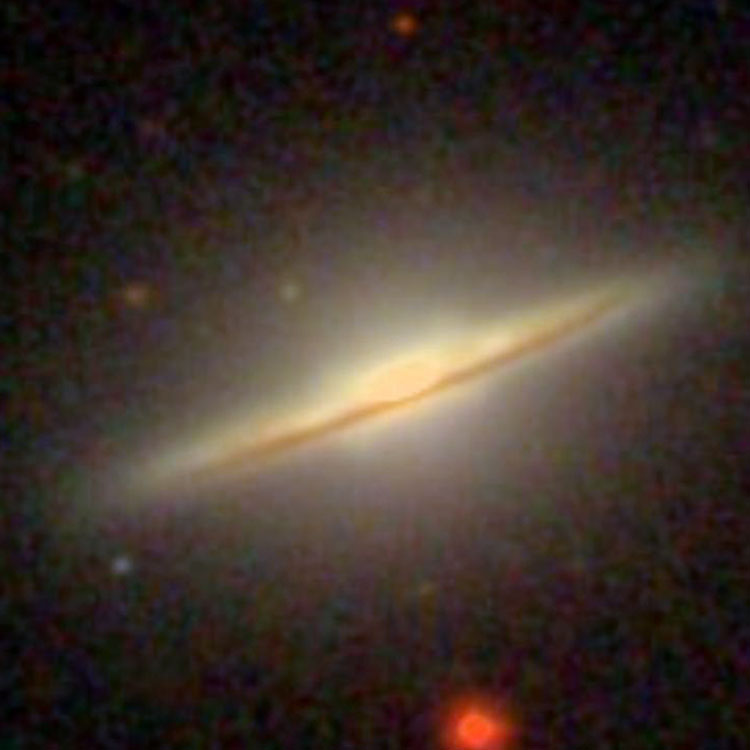
NGC 3043 (= PGC 28672)
Discovered (Mar 19, 1790) by William Herschel
Also observed (Feb 9, 1831) by John Herschel
A magnitude 12.6 spiral galaxy (type SBbc?) in Ursa Major (RA 09 56 14.8, Dec +59 18 26)
Historical Identification: Per Dreyer, NGC 3043 (= GC 1957 = JH 651 = WH II 835, 1860 RA 09 46 19, NPD 30 02.7) is "considerably faint, pretty small, a little extended, very gradually brighter middle, 10th magnitude star 7 arcmin to north". The position precesses to RA 09 56 19.2, Dec +59 17 43, less than 0.9 arcmin southeast of the galaxy listed above, the description fits (including the 8th magnitude star to the north) and there is nothing else nearby so the identification is certain.
Physical Information: Based on a recessional velocity of 2995 km/sec, NGC 3043 is about 140 million light years away, in reasonable agreement with redshift-independent distance estimates of 150 to 155 million light years. Given that and its apparent size of 1.5 by 0.45 arcmin, it is about 60 thousand light years across.
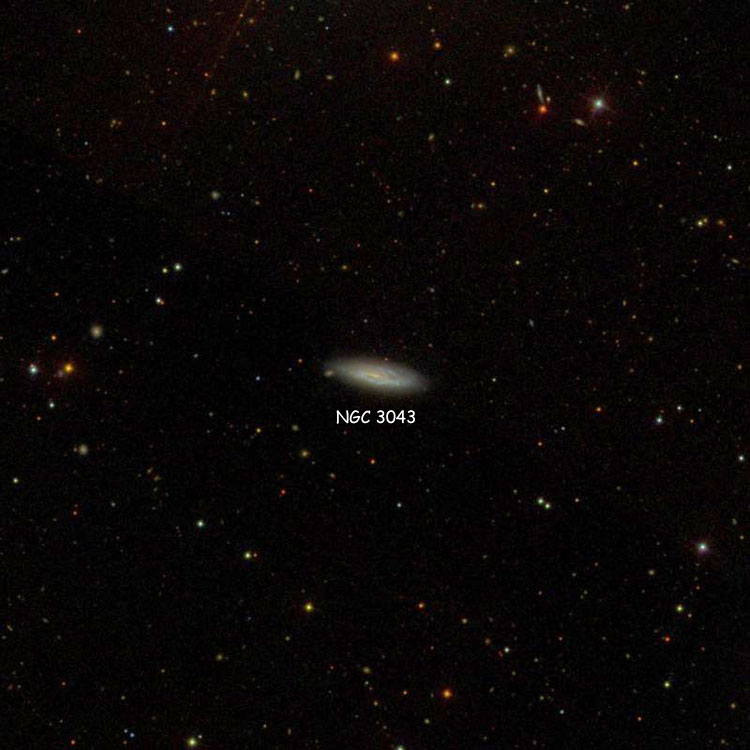
Above, a 12 arcmin wide SDSS image centered on NGC 3043
Below, a 1.8 arcmin wide SDSS image of the galaxy

NGC 3044 (= PGC 28517)
Discovered (Dec 13, 1784) by William Herschel
Also observed (Jan 27, 1832) by John Herschel
A magnitude 11.9 spiral galaxy (type SB(s)cd?) in Sextans (RA 09 53 40.8, Dec +01 34 47)
Historical Identification: Per Dreyer, NGC 3044 (= GC 1958 = JH 652 = WH III 254, 1860 RA 09 46 27, NPD 87 46.0) is "very faint, very large, very much extended 122°". The position precesses to RA 09 53 40.6, Dec +01 34 33, on the southern rim of the galaxy listed above, the description fits perfectly and there is nothing else nearby so the identification is certain.
Discovery Notes: Dreyer's 1877 Supplement to the GC notes that the GC 1958's NPD should be changed from 87 55 to 87 45, which is approximately the value recorded in the NGC.
Physical Information: Based on a recessional velocity of 1290 km/sec, NGC 3044 is about 60 million light years away, in good agreement with redshift-independent distance estimates of 55 to 85 million light years. Given that and its apparent size of 4.8 by 0.4 arcmin, it is about 85 thousand light years across. The galaxy is seen nearly edge-on, and though its disk displays some thickness there is little or no evidence of a nuclear bulge.

Above, a 12 arcmin wide SDSS image centered on NGC 3044
Below, a 5 arcmin wide SDSS image of the galaxy
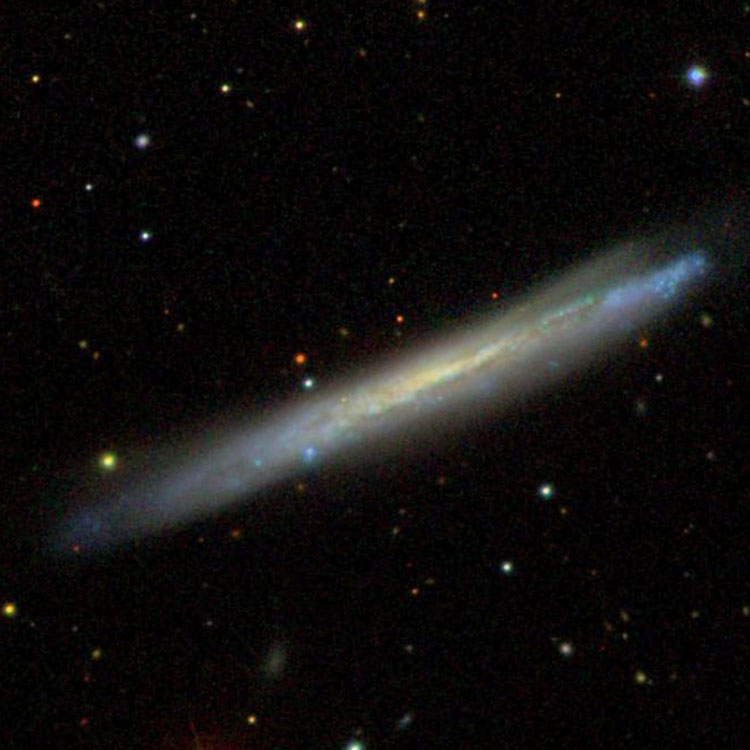
NGC 3045 (= PGC 28492 = PGC 28493)
Discovered (Mar 23, 1835) by John Herschel
A magnitude 13.0 spiral galaxy (type SAB(s)bc?) in Hydra (RA 09 53 17.6, Dec -18 38 42)
Historical Identification: Per Dreyer, NGC 3045 (= GC 1959 = JH 3198, 1860 RA 09 46 39, NPD 107 59.1) is "very faint, pretty small, round, a little brighter middle, southwestern of 2", the other being NGC 3052. The position precesses to RA 09 53 16.0, Dec -18 38 33, less than half an arcmin west northwest of the center of the galaxy listed above, the description fits save for being west instead of southwest of NGC 3052 and there is nothing comparable nearby, so the identification is certain.
Physical Information: Based on a recessional velocity of 2250 km/sec, NGC 3045 is about 105 million light years away, in good agreement with redshift-independent distance estimates of 95 to 160 million light years. Given that and its apparent size of 1.3 by 0.65 arcmin, it is about 40 thousand light years across.

Above, a 12 arcmin wide DSS image centered on NGC 3045
Below, a 1.4 arcmin wide DSS image of the galaxy
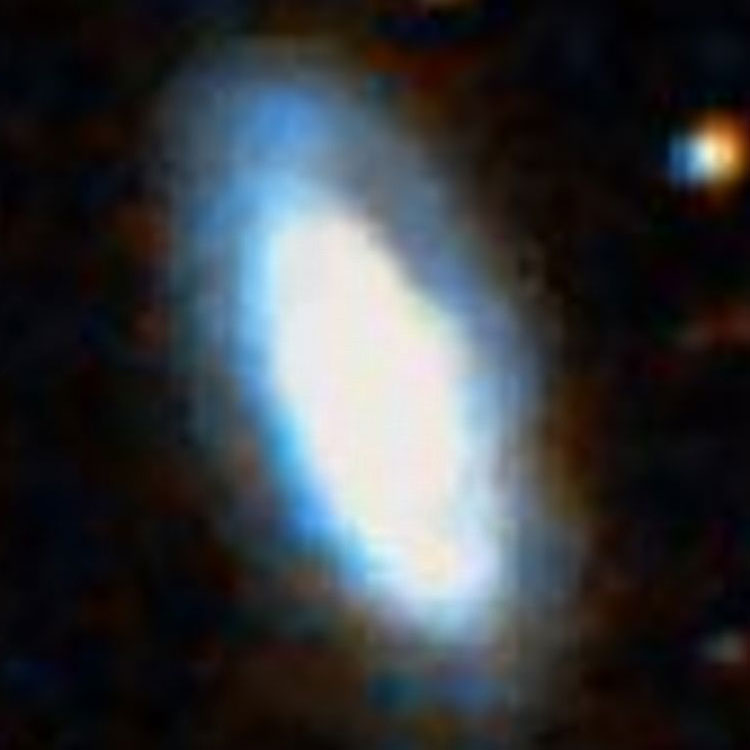
Below, a 0.75 by 1.0 arcmin wide image of part of the galaxy
(Image Credit Hubble Legacy Archive images superimposed on a DSS background)

NGC 3046 (perhaps = NGC 3051 = PGC 28536)
Recorded (Mar 24, 1835) by John Herschel (and later listed as NGC 3046)
Perhaps also observed (Mar 24, 1835) by John Herschel (and later listed as NGC 3051)
Probably a lost or nonexistent object in Antlia (near RA 09 53 21.1, Dec -27 19 52)
or perhaps a misrecorded observation of NGC 3051 (RA 09 53 58.6, Dec -27 17 11)
Historical Identification: Per Dreyer, NGC 3046 (= GC 1960 = JH 3199, 1860 RA 09 47 02, NPD 116 40.4) is "pretty faint, round, southwestern of 2", the other being NGC 3051. The position precesses to RA 09 53 21.1, Dec -27 19 52 (whence the position above), but there is nothing there save NGC 3051, which lies almost 9 arcmin to the east northeast. Under the circumstances, it appears that NGC 3046 is either a lost or nonexistent object (as noted above), or a duplicate observation of NGC 3051 (as also noted above).
Discovery Notes: Per Corwin, it would not be unprecedented for an observer to mistake a single object for two different objects, given the way in which early observers "swept" across the sky by moving their instruments primarily north and south in a narrow strip of declination while the sky moved to the west. William Herschel is known to have done this at least twice, and since his son used essentially the same observing techniques, it would hardly be surprising if he made the same mistake at least once. In this case, his first observation (NGC 3051) was carefully and accurately done, but the second was by Herschel's own statement a hurried observation, and its right ascension was marked with double colons to indicate a "precarious" position. If this was all there was to the matter, we would conclude that NGC 3046 is "certainly" a duplicate observation of NGC 3051; but in the GC Herschel states that the two "are also distinct nebulae, and were observed consecutively". Corwin's conclusion is that NGC 3046 is probably a duplicate of NGC 3051, but not certainly; and there is no reason for me to argue otherwise, hence my listing it as "perhaps" a duplicate entry.

Above, a 12 arcmin wide DSS image centered on the NGC position for NGC 3046
NGC 3047 (= PGC 28577 = "PGC 3167253")
Discovered (Apr 24, 1883) by George Hough and Sherburne Burnham
A magnitude 14.1 lenticular galaxy (type S0(rs)a?) in Sextans (RA 09 54 32.1, Dec -01 17 27)
Historical Identification: Per Dreyer, NGC 3047 (Burnham and Hough (1), 1860 RA 09 47 15, NPD 90 37.7) is "very faint, small, round". The position precesses to RA 09 54 23.6, Dec -01 17 14, just over 2 arcmin west of the galaxy listed above, but the description fits and there is nothing else nearby that Burnham and Hough could have seen, so the identification is certain. (LEDA lists PGC 28577 as = NGC 3047A = NGC 3047, but a search of the LEDA database for NGC 3047 returns PGC 3167253 (at the position listed above), and a search for PGC 3167253 does not return any result.)
Discovery Notes: Burnham and Hough were observing together at the time they found NGC 3047, hence their listing as co-discoverers.
Physical Information: Based on a recessional velocity of 6155 km/sec, NGC 3047 is about 285 million light years away. Given that and its apparent size of 0.5 by 0.5 arcmin, it is about 40 thousand light years across.
Given NGC 3047's apparent proximity to PGC 28572 and their similar recessional velocities it is possible that they are a physical pair (and as a result are listed as such in NED), but they cannot be as close as they appear or they would be noticeably distorted by physical or gravitational interactions; so one or the other must be closer to us, and they could very well have the ten million light year difference in their distance implied by their recessional velocities.

Above, a 12 arcmin wide SDSS image centered on NGC 3047
Below, a 0.8 arcmin wide SDSS image of the galaxy

Below, a 12 arcmin wide image centered on NGC 3047, also showing PGC 28572
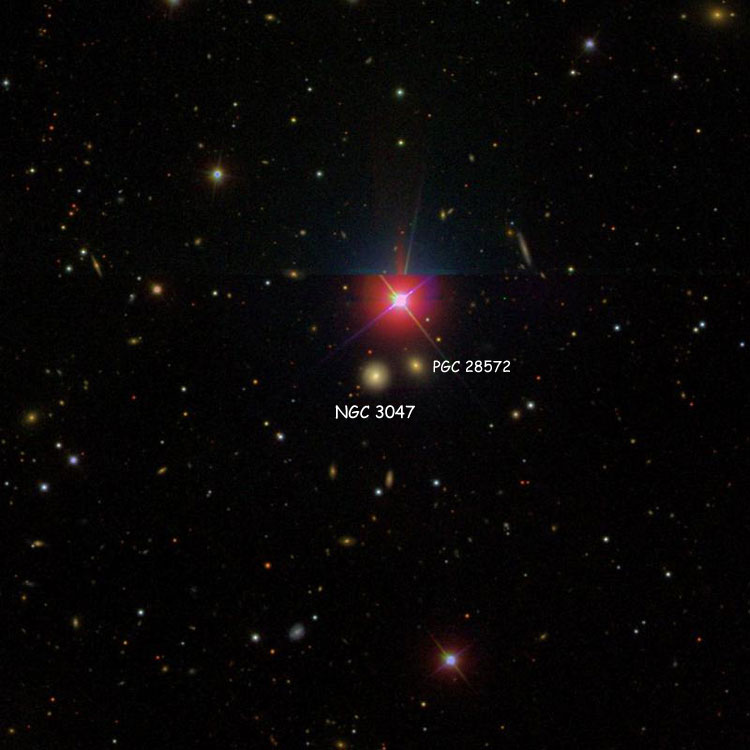
PGC 28572 (= "NGC 3047A" and = "NGC 3047B")
Not an NGC object but listed here since often mis-designated as NGC 3047A or 3047B
A magnitude 13.2 elliptical galaxy (type E1?) at RA 09 54 29.5, Dec -01 17 17 (see Corwin)
A Warning About Non-Standard Designations: PGC 28572 is often called NGC 3047A (a term often mis-used for NGC 3047 itself), and sometimes called NGC 3047B. Neither of these NGC+letter designations does anything useful, and their multiplicity serves as a good example of how using such non-standard designations should be strongly discouraged (unfortunately it cannot be forbidden, as there are no legally enforceable rules about such things).
Physical Information: Based on a recessional velocity of 5905 km/sec, PGC 28572 is about 275 million light years away. Given that and its apparent size of 0.3 by 0.27 arcmin, it is about 25 thousand light years across.
Given PGC 28572's apparent proximity to NGC 3047 and their similar recessional velocities it is possible that they are a physical pair (and as a result are listed as such in NED), but they cannot be as close as they appear or they would be noticeably distorted by physical or gravitational interactions; so one or the other must be closer to us, and they could very well have the ten million light year difference in their distance implied by their recessional velocities.
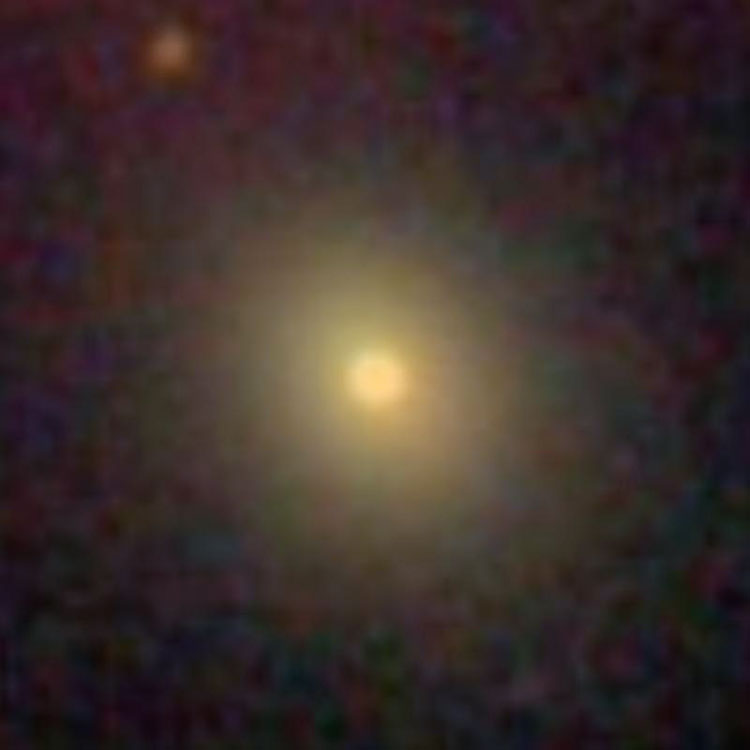
Above, a 0.6 arcmin wide SDSS image of PGC 28572; for a wide-field view see NGC 3047
NGC 3048 (= PGC 28595 + PGC 1509261) = "PGC 5067083"
Discovered (Apr 27, 1864) by Albert Marth
A pair of galaxies in Leo
PGC 28595 = A magnitude 14.4 spiral galaxy (type SAB(s)b?) at RA 09 54 56.5, Dec +16 27 23
PGC 1509261 = A magnitude 15.2 spiral galaxy (type Sa?) at RA 09 54 58.0, Dec +16 27 35
Historical Identification: Per Dreyer, NGC 3048 (= GC 5510, Marth 186, 1860 RA 09 47 17, NPD 72 53) is "extremely faint". The position precesses to RA 09 54 57.4, Dec +16 27 26, directly between the galaxies listed above, the description fits and there is nothing else nearby so the identification is certain.
Discovery Notes: If Marth had seen both galaxies he would probably have noted that the object was "extended", so only the brighter member of the pair is certainly part of NGC 3048, and as it happens the "pair" is only an optical double, so it wouldn't hurt to equate NGC 3048 with PGC 28595, and treat PGC 1509261 only as an apparent companion; but LEDA and NED both treat NGC 3048 as a pair and that appears to be the general usage, so I have followed their lead. There is also a much fainter companion that is certainly not part of the NGC entry, but is probably interacting with PGC 1509261, so I have given it a separate entry immediately below. (LEDA not only lists the individual galaxies, but also lists NGC 3048 as the pair of galaxies with the designation PGC 5067083, but a search for that designation does not return a result.)
Physical Information: All major references have muddled the assignment of recessional velocities for the three galaxies, placing PGC 1509261 in front of the other two, whereas the images below show that it must be behind them. At my request Dr. Corwin looked into the matter and confirmed the error, so although the recessional velocities shown here do not agree with other references, their values and the conclusions drawn from them are correct.
Based on a recessional velocity of 8860 km/sec, a straightforward calculation indicates that PGC 28595 is 410 to 415 million light years away. However, for objects at such distances we should take into account the expansion of the Universe during the time it took their light to reach us. Doing that shows that the galaxy was 395 to 400 million light years away at the time the light by which we see it was emitted, about 405 million years ago (the difference between the two numbers being due to the expansion of the intervening space during the light-travel time). Given that and its apparent size of about 0.7 by 0.4 arcmin, the galaxy is 80 to 85 thousand light years across.
Based on a recessional velocity of 10040 km/sec, a straightforward calculation indicates that PGC 1509261 is 465 to 470 million light years away, so it is definitely not connected to PGC 28595 save for being in the same direction, and they are merely an optical double (on the other hand, PGC 1509261 is almost certainly an interacting pair with its fainter companion). However, for objects at such distances we should take into account the expansion of the Universe during the time it took their light to reach us. Doing that shows that the galaxy was about 450 million light years away at the time the light by which we see it was emitted, 455 to 460 million years ago (the difference between the two numbers being due to the expansion of the intervening space during the light-travel time). Given that and its apparent size of about 0.35 by 0.2 arcmin, the galaxy is about 45 thousand light years across.
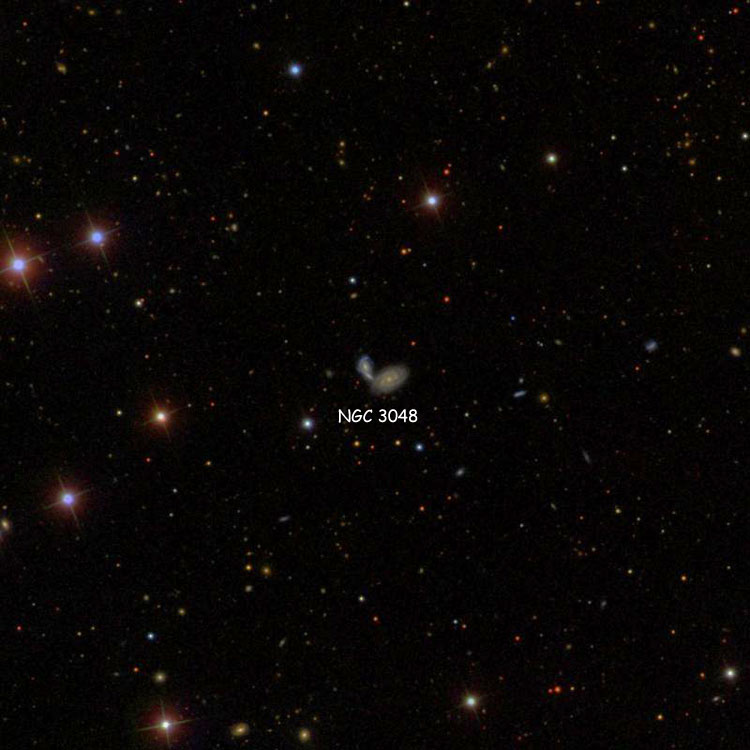
Above, a 12 arcmin wide SDSS image centered on NGC 3048
Below, a 1 arcmin wide SDSS image of the galaxies in the apparent triplet

SDSS J095457.79+162725.6 (= J095458+162726 in images)
Not an NGC object but listed here as a physical companion of PGC 1509261
A magnitude 16(?) spiral galaxy (type Sb? pec) in Leo (RA 09 54 57.8, Dec +16 27 26)
Historical Identification: J095457.79+162725.6 is sometimes treated as part of a triple with PGC 28595 and PGC 1509261, but it is far too faint to have been seen by Marth, so it is definitely not part of NGC 3048; but as a probable physical companion of PGC 1509261 it is deserving of some mention, hence this entry.
Physical Information: Based on a recessional velocity of 10035 km/sec, a straightforward calculation indicates that J095457.79+162725.6 is 465 to 470 million light years away. However, for objects at such distances we should take into account the expansion of the Universe during the time it took their light to reach us. Doing that shows that the galaxy was about 450 million light years away at the time the light by which we see it was emitted, 455 to 460 million years ago (the difference between the two numbers being due to the expansion of the intervening space during the light-travel time). Given that and its apparent size of 0.25 by 0.08 arcmin (if it only includes the straight "bar" on the southern rim of PGC 1509261), the galaxy is 30 to 35 thousand light years across. Given their essentially identical distance from us, J095457.79+162725.6 and PGC 1509261 are probably a physical pair, with J0957457.79+162725.6 very slightly in front from our point of view. It appears likely that the oddly placed arm on the northeastern rim of PGC 1509261 is not part of that galaxy, but a distorted extension of J095457.79+162725.6 (in which case that galaxy is about 0.4 by 0.2 arcmin in size, and about 50 to 55 thousand light years across), and if so the two galaxies must be an interacting pair.
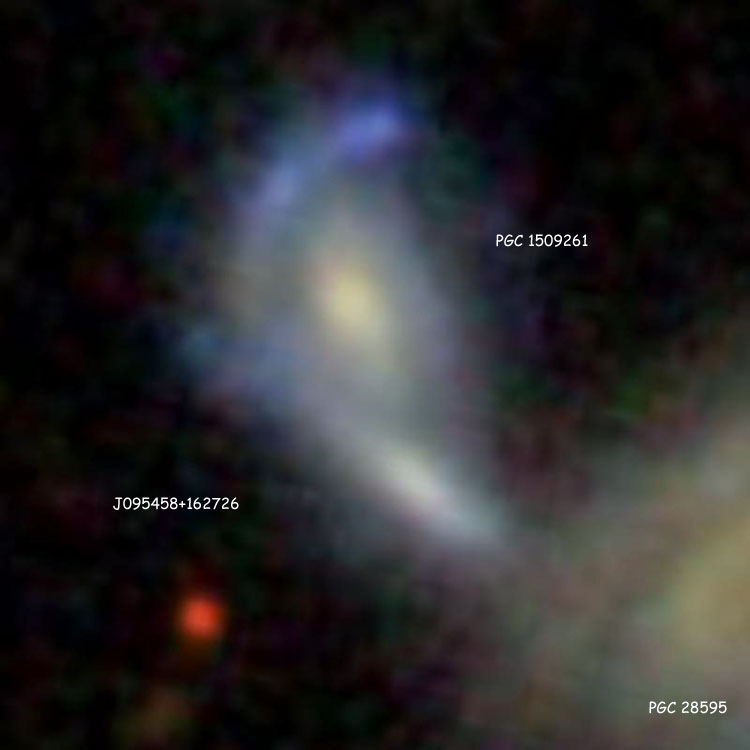
Above, a 0.6 arcmin wide SDSS image of J095457.79+162725.6 and PGC 1509261
Also shown is part of PGC 28595, the main component of NGC 3048, which see for other images
NGC 3049 (= PGC 28590)
Discovered (Mar 20, 1882) by Édouard Stephan
A magnitude 12.1 spiral galaxy (type SB(rs)b?) in Leo (RA 09 54 49.6, Dec +09 16 17)
Historical Identification: Per Dreyer, NGC 3049 (Stephan list XII (#37), 1860 RA 09 47 23, NPD 80 04.1) is "very faint, very small, faint star very near". The position precesses to RA 09 54 50.1, Dec +09 16 20, right on the galaxy listed above and there is nothing else nearby so the identification is certain.
Physical Information: Based on a recessional velocity of 1455 km/sec, NGC 3049 is about 65 to 70 million light years away, in good agreement with redshift-independent distance estimates of 50 to 105 million light years. Given that and its apparent size of 2.2 by 1.3 arcmin, it is about 45 thousand light years across. NGC 3049 is listed as a starburst galaxy.

Above, a 12 arcmin wide SDSS image centered on NGC 3049
Below, a 2.4 arcmin wide SDSS image of the galaxy
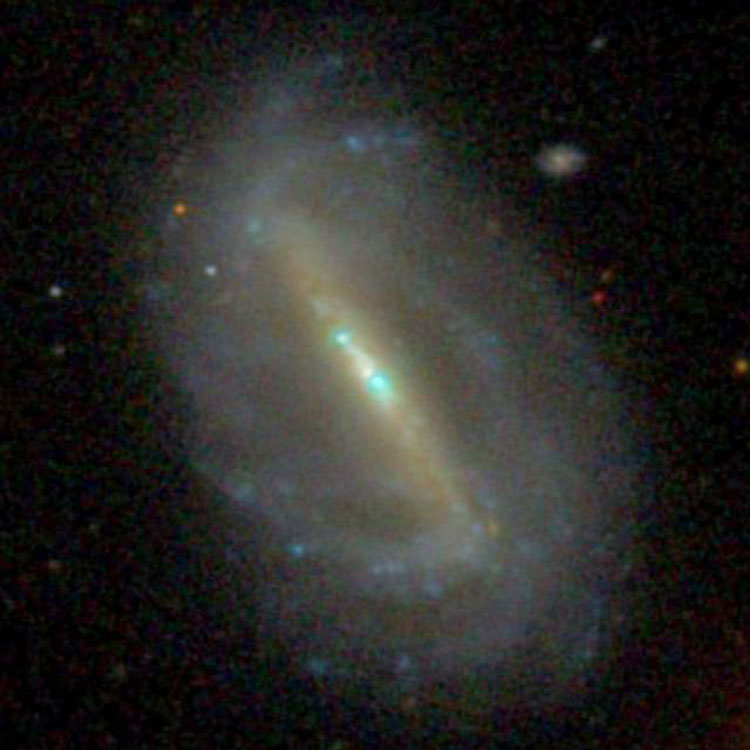
|